Financial Performance Analysis of Vodafone Plc and BT Group Plc
VerifiedAdded on 2023/01/24
|25
|4029
|59
AI Summary
This report provides a detailed analysis of the financial performance of Vodafone Plc and its competitor, BT Group Plc in the UK telecommunications sector. It includes liquidity analysis, profitability analysis, efficiency analysis, and capital structure analysis. Based on the analysis, recommendations are provided for investing in the shares of the two organizations.
Contribute Materials
Your contribution can guide someone’s learning journey. Share your
documents today.
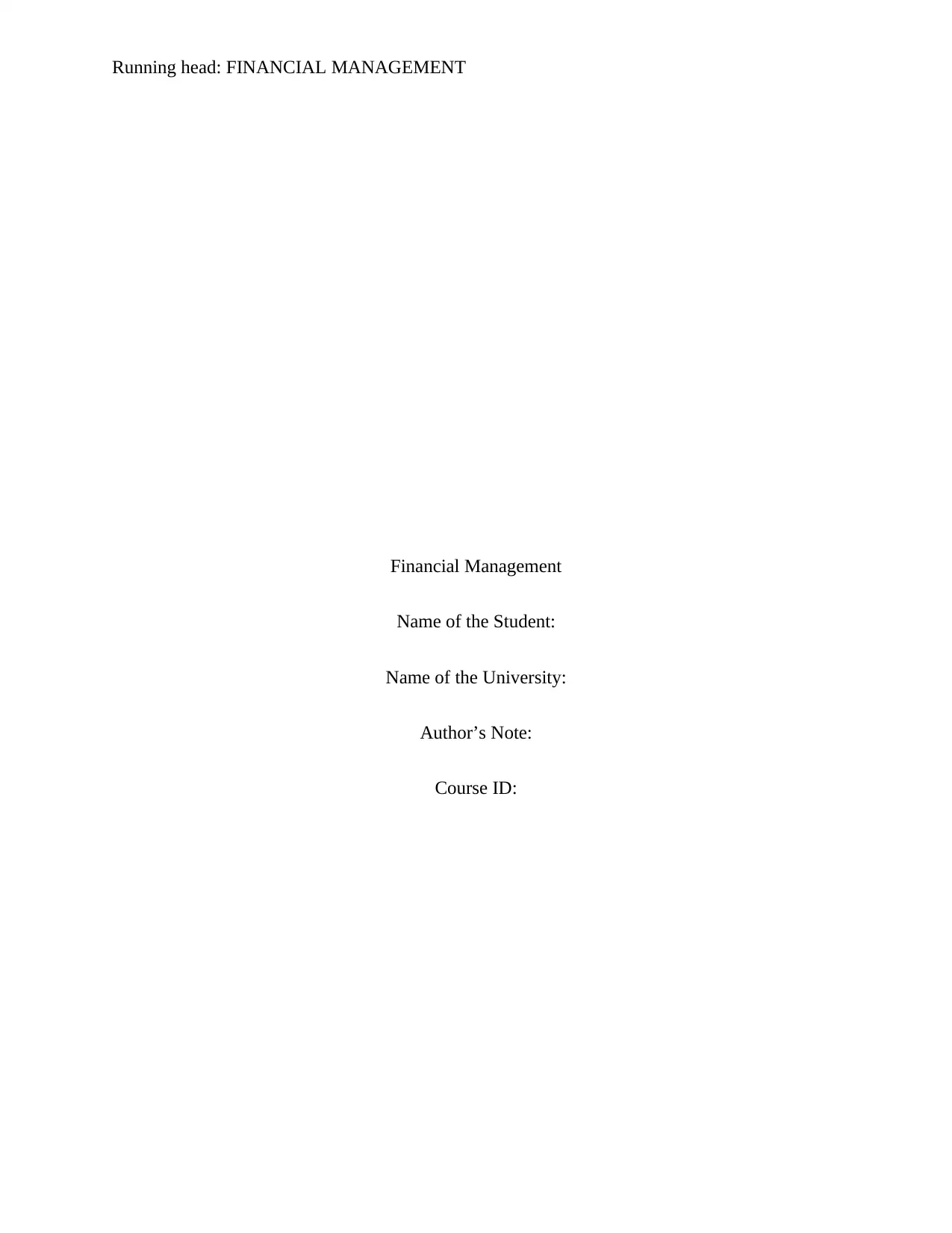
Running head: FINANCIAL MANAGEMENT
Financial Management
Name of the Student:
Name of the University:
Author’s Note:
Course ID:
Financial Management
Name of the Student:
Name of the University:
Author’s Note:
Course ID:
Secure Best Marks with AI Grader
Need help grading? Try our AI Grader for instant feedback on your assignments.

1FINANCIAL MANAGEMENT
Executive Summary:
For the current report, the organisation chosen is Vodafone Plc and its major competitor, BT
Group Plc operating in the UK telecommunication and utilities sector. From the conducted
analysis, it is apparent that BT Group Plc is in a better position than Vodafone Plc in the UK
telecommunications sector owing to better financial performance in the past five years. In
addition, by considering stock market performance, the investors are recommended to invest in
the shares of BT Group for maximising their return on investment. However, the analysis is
subject to certain limitations, since it has considered historical data only for decision-making.
Therefore, research reports and price/earnings ratio have been taken into consideration, which
reveal that the performance of BT Group is expected to decline in the upcoming years, especially
in terms of earnings per share and dividend payments. Hence, the investors need to consider
these aspects as well before investing in the shares of BT Group Plc.
Executive Summary:
For the current report, the organisation chosen is Vodafone Plc and its major competitor, BT
Group Plc operating in the UK telecommunication and utilities sector. From the conducted
analysis, it is apparent that BT Group Plc is in a better position than Vodafone Plc in the UK
telecommunications sector owing to better financial performance in the past five years. In
addition, by considering stock market performance, the investors are recommended to invest in
the shares of BT Group for maximising their return on investment. However, the analysis is
subject to certain limitations, since it has considered historical data only for decision-making.
Therefore, research reports and price/earnings ratio have been taken into consideration, which
reveal that the performance of BT Group is expected to decline in the upcoming years, especially
in terms of earnings per share and dividend payments. Hence, the investors need to consider
these aspects as well before investing in the shares of BT Group Plc.
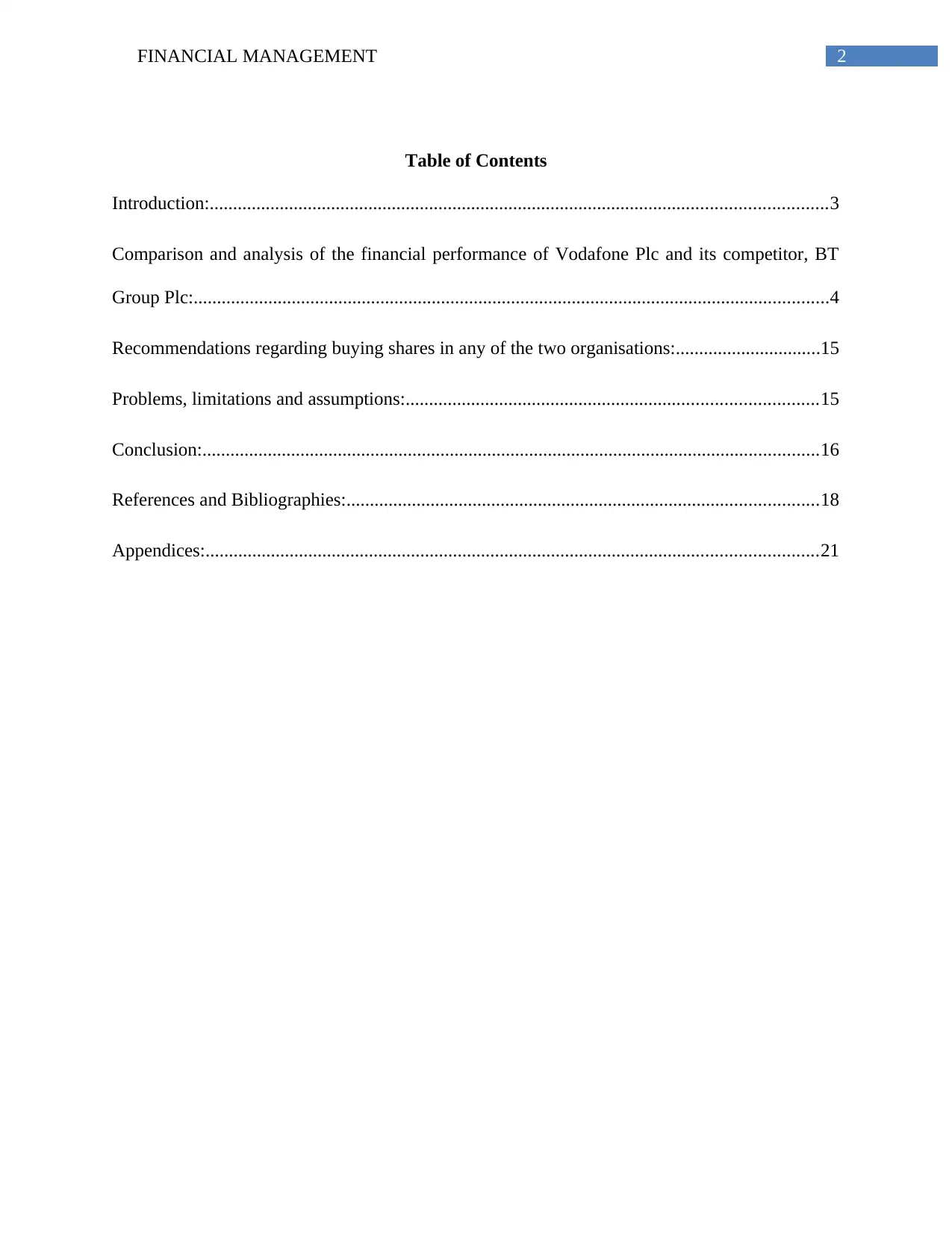
2FINANCIAL MANAGEMENT
Table of Contents
Introduction:....................................................................................................................................3
Comparison and analysis of the financial performance of Vodafone Plc and its competitor, BT
Group Plc:........................................................................................................................................4
Recommendations regarding buying shares in any of the two organisations:...............................15
Problems, limitations and assumptions:........................................................................................15
Conclusion:....................................................................................................................................16
References and Bibliographies:.....................................................................................................18
Appendices:...................................................................................................................................21
Table of Contents
Introduction:....................................................................................................................................3
Comparison and analysis of the financial performance of Vodafone Plc and its competitor, BT
Group Plc:........................................................................................................................................4
Recommendations regarding buying shares in any of the two organisations:...............................15
Problems, limitations and assumptions:........................................................................................15
Conclusion:....................................................................................................................................16
References and Bibliographies:.....................................................................................................18
Appendices:...................................................................................................................................21
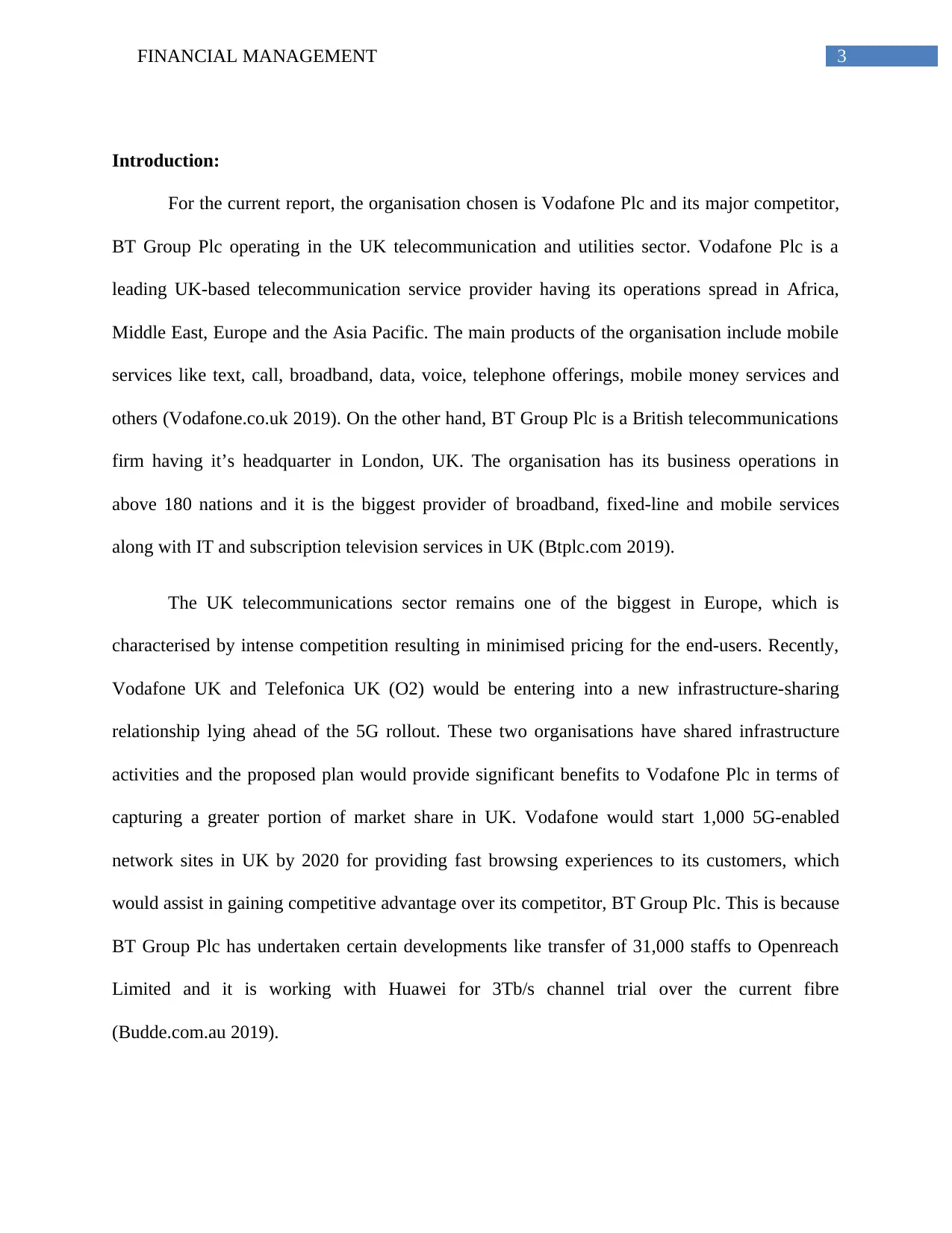
3FINANCIAL MANAGEMENT
Introduction:
For the current report, the organisation chosen is Vodafone Plc and its major competitor,
BT Group Plc operating in the UK telecommunication and utilities sector. Vodafone Plc is a
leading UK-based telecommunication service provider having its operations spread in Africa,
Middle East, Europe and the Asia Pacific. The main products of the organisation include mobile
services like text, call, broadband, data, voice, telephone offerings, mobile money services and
others (Vodafone.co.uk 2019). On the other hand, BT Group Plc is a British telecommunications
firm having it’s headquarter in London, UK. The organisation has its business operations in
above 180 nations and it is the biggest provider of broadband, fixed-line and mobile services
along with IT and subscription television services in UK (Btplc.com 2019).
The UK telecommunications sector remains one of the biggest in Europe, which is
characterised by intense competition resulting in minimised pricing for the end-users. Recently,
Vodafone UK and Telefonica UK (O2) would be entering into a new infrastructure-sharing
relationship lying ahead of the 5G rollout. These two organisations have shared infrastructure
activities and the proposed plan would provide significant benefits to Vodafone Plc in terms of
capturing a greater portion of market share in UK. Vodafone would start 1,000 5G-enabled
network sites in UK by 2020 for providing fast browsing experiences to its customers, which
would assist in gaining competitive advantage over its competitor, BT Group Plc. This is because
BT Group Plc has undertaken certain developments like transfer of 31,000 staffs to Openreach
Limited and it is working with Huawei for 3Tb/s channel trial over the current fibre
(Budde.com.au 2019).
Introduction:
For the current report, the organisation chosen is Vodafone Plc and its major competitor,
BT Group Plc operating in the UK telecommunication and utilities sector. Vodafone Plc is a
leading UK-based telecommunication service provider having its operations spread in Africa,
Middle East, Europe and the Asia Pacific. The main products of the organisation include mobile
services like text, call, broadband, data, voice, telephone offerings, mobile money services and
others (Vodafone.co.uk 2019). On the other hand, BT Group Plc is a British telecommunications
firm having it’s headquarter in London, UK. The organisation has its business operations in
above 180 nations and it is the biggest provider of broadband, fixed-line and mobile services
along with IT and subscription television services in UK (Btplc.com 2019).
The UK telecommunications sector remains one of the biggest in Europe, which is
characterised by intense competition resulting in minimised pricing for the end-users. Recently,
Vodafone UK and Telefonica UK (O2) would be entering into a new infrastructure-sharing
relationship lying ahead of the 5G rollout. These two organisations have shared infrastructure
activities and the proposed plan would provide significant benefits to Vodafone Plc in terms of
capturing a greater portion of market share in UK. Vodafone would start 1,000 5G-enabled
network sites in UK by 2020 for providing fast browsing experiences to its customers, which
would assist in gaining competitive advantage over its competitor, BT Group Plc. This is because
BT Group Plc has undertaken certain developments like transfer of 31,000 staffs to Openreach
Limited and it is working with Huawei for 3Tb/s channel trial over the current fibre
(Budde.com.au 2019).
Secure Best Marks with AI Grader
Need help grading? Try our AI Grader for instant feedback on your assignments.
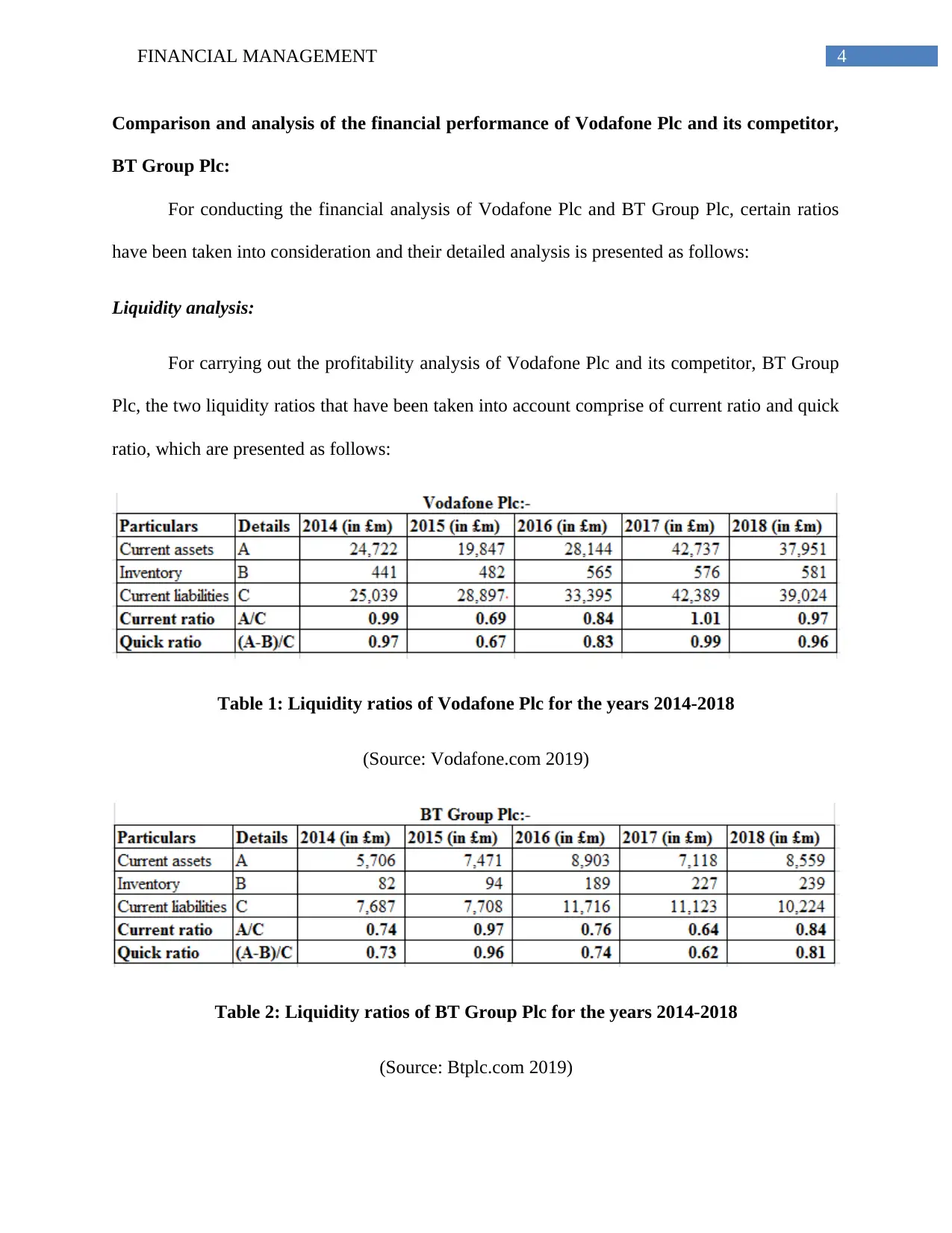
4FINANCIAL MANAGEMENT
Comparison and analysis of the financial performance of Vodafone Plc and its competitor,
BT Group Plc:
For conducting the financial analysis of Vodafone Plc and BT Group Plc, certain ratios
have been taken into consideration and their detailed analysis is presented as follows:
Liquidity analysis:
For carrying out the profitability analysis of Vodafone Plc and its competitor, BT Group
Plc, the two liquidity ratios that have been taken into account comprise of current ratio and quick
ratio, which are presented as follows:
Table 1: Liquidity ratios of Vodafone Plc for the years 2014-2018
(Source: Vodafone.com 2019)
Table 2: Liquidity ratios of BT Group Plc for the years 2014-2018
(Source: Btplc.com 2019)
Comparison and analysis of the financial performance of Vodafone Plc and its competitor,
BT Group Plc:
For conducting the financial analysis of Vodafone Plc and BT Group Plc, certain ratios
have been taken into consideration and their detailed analysis is presented as follows:
Liquidity analysis:
For carrying out the profitability analysis of Vodafone Plc and its competitor, BT Group
Plc, the two liquidity ratios that have been taken into account comprise of current ratio and quick
ratio, which are presented as follows:
Table 1: Liquidity ratios of Vodafone Plc for the years 2014-2018
(Source: Vodafone.com 2019)
Table 2: Liquidity ratios of BT Group Plc for the years 2014-2018
(Source: Btplc.com 2019)

5FINANCIAL MANAGEMENT
2014 2015 2016 2017 2018 2014 2015 2016 2017 2018
Vodafone Plc BT Group Plc
-
0.20
0.40
0.60
0.80
1.00
1.20
Liquidity Ratios
Current ratio
Quick ratio
Figure 1: Liquidity ratios of Vodafone Plc and BT Group Plc for the years 2014-2018
(Source: Vodafone.com 2019: Btplc.com 2019)
From the above tables and figure, it could be seen that the current ratio of Vodafone Plc
after witnessing sharp decline in 2015 has increased until 2017; however, there has been a slight
decline in 2018. In this context, Baños-Caballero, García-Teruel and Martínez-Solano (2014)
stated that current ratio represents the ability of covering short-term obligations and dues by
current assets. Current ratio has declined in 2018 because of the fall in current assets, especially
cash and cash equivalents during the financial year. On the other hand, the current ratio for BT
Group Plc is observed to be fluctuating over the years and the ratio is below Vodafone Plc from
2016 to 2018. However, the ratio for both the organisations is well below the ideal standard of
2:1. Hence, they need to be cautious while dealing with short-term liabilities.
Quick ratio, on the other hand, implies short-term liquidity and from the above table, it
could be identified that the position for Vodafone Plc is better in comparison to BT Group Plc.
However, it has been observed that the ratio for both the organisations is close to the ideal
2014 2015 2016 2017 2018 2014 2015 2016 2017 2018
Vodafone Plc BT Group Plc
-
0.20
0.40
0.60
0.80
1.00
1.20
Liquidity Ratios
Current ratio
Quick ratio
Figure 1: Liquidity ratios of Vodafone Plc and BT Group Plc for the years 2014-2018
(Source: Vodafone.com 2019: Btplc.com 2019)
From the above tables and figure, it could be seen that the current ratio of Vodafone Plc
after witnessing sharp decline in 2015 has increased until 2017; however, there has been a slight
decline in 2018. In this context, Baños-Caballero, García-Teruel and Martínez-Solano (2014)
stated that current ratio represents the ability of covering short-term obligations and dues by
current assets. Current ratio has declined in 2018 because of the fall in current assets, especially
cash and cash equivalents during the financial year. On the other hand, the current ratio for BT
Group Plc is observed to be fluctuating over the years and the ratio is below Vodafone Plc from
2016 to 2018. However, the ratio for both the organisations is well below the ideal standard of
2:1. Hence, they need to be cautious while dealing with short-term liabilities.
Quick ratio, on the other hand, implies short-term liquidity and from the above table, it
could be identified that the position for Vodafone Plc is better in comparison to BT Group Plc.
However, it has been observed that the ratio for both the organisations is close to the ideal
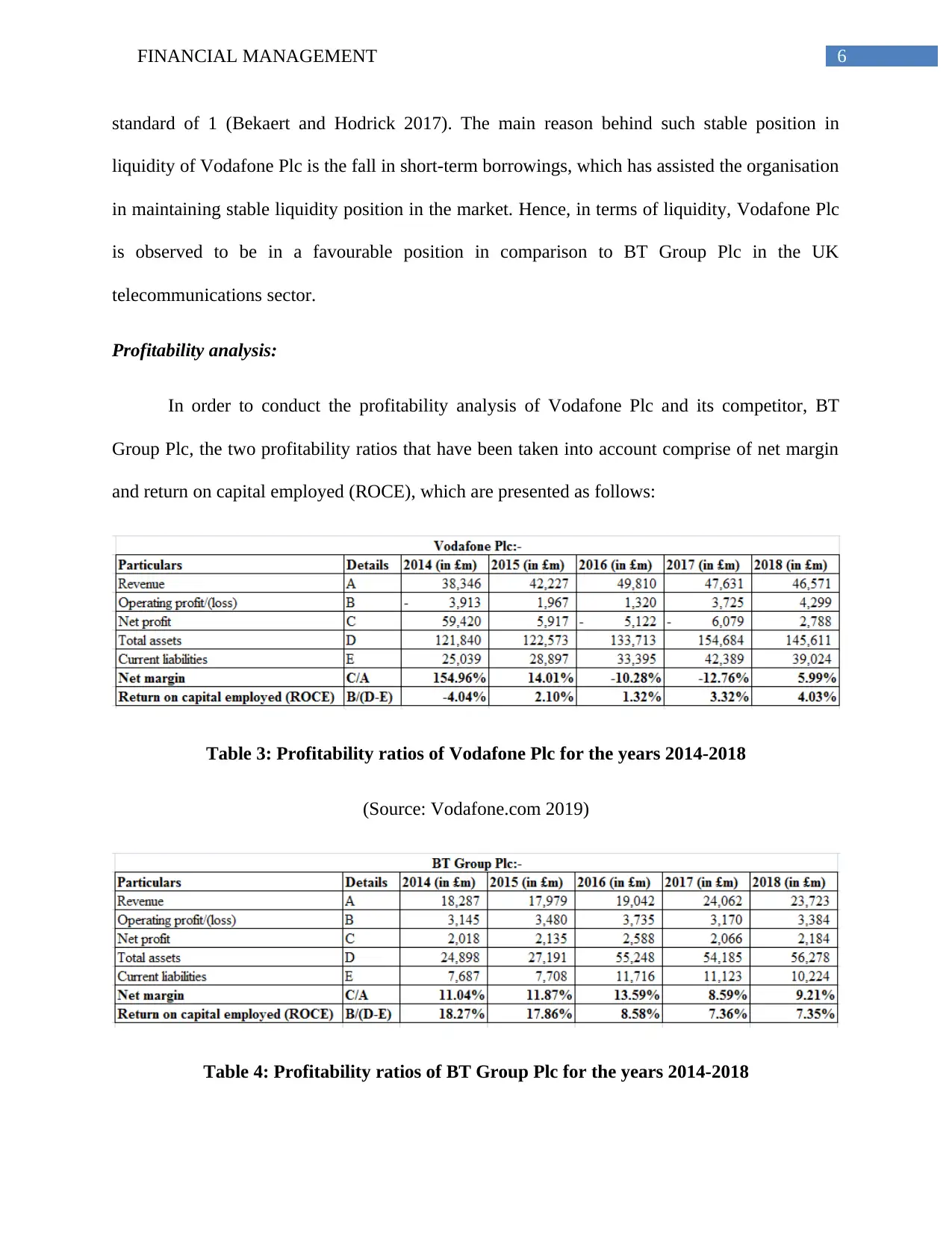
6FINANCIAL MANAGEMENT
standard of 1 (Bekaert and Hodrick 2017). The main reason behind such stable position in
liquidity of Vodafone Plc is the fall in short-term borrowings, which has assisted the organisation
in maintaining stable liquidity position in the market. Hence, in terms of liquidity, Vodafone Plc
is observed to be in a favourable position in comparison to BT Group Plc in the UK
telecommunications sector.
Profitability analysis:
In order to conduct the profitability analysis of Vodafone Plc and its competitor, BT
Group Plc, the two profitability ratios that have been taken into account comprise of net margin
and return on capital employed (ROCE), which are presented as follows:
Table 3: Profitability ratios of Vodafone Plc for the years 2014-2018
(Source: Vodafone.com 2019)
Table 4: Profitability ratios of BT Group Plc for the years 2014-2018
standard of 1 (Bekaert and Hodrick 2017). The main reason behind such stable position in
liquidity of Vodafone Plc is the fall in short-term borrowings, which has assisted the organisation
in maintaining stable liquidity position in the market. Hence, in terms of liquidity, Vodafone Plc
is observed to be in a favourable position in comparison to BT Group Plc in the UK
telecommunications sector.
Profitability analysis:
In order to conduct the profitability analysis of Vodafone Plc and its competitor, BT
Group Plc, the two profitability ratios that have been taken into account comprise of net margin
and return on capital employed (ROCE), which are presented as follows:
Table 3: Profitability ratios of Vodafone Plc for the years 2014-2018
(Source: Vodafone.com 2019)
Table 4: Profitability ratios of BT Group Plc for the years 2014-2018
Paraphrase This Document
Need a fresh take? Get an instant paraphrase of this document with our AI Paraphraser
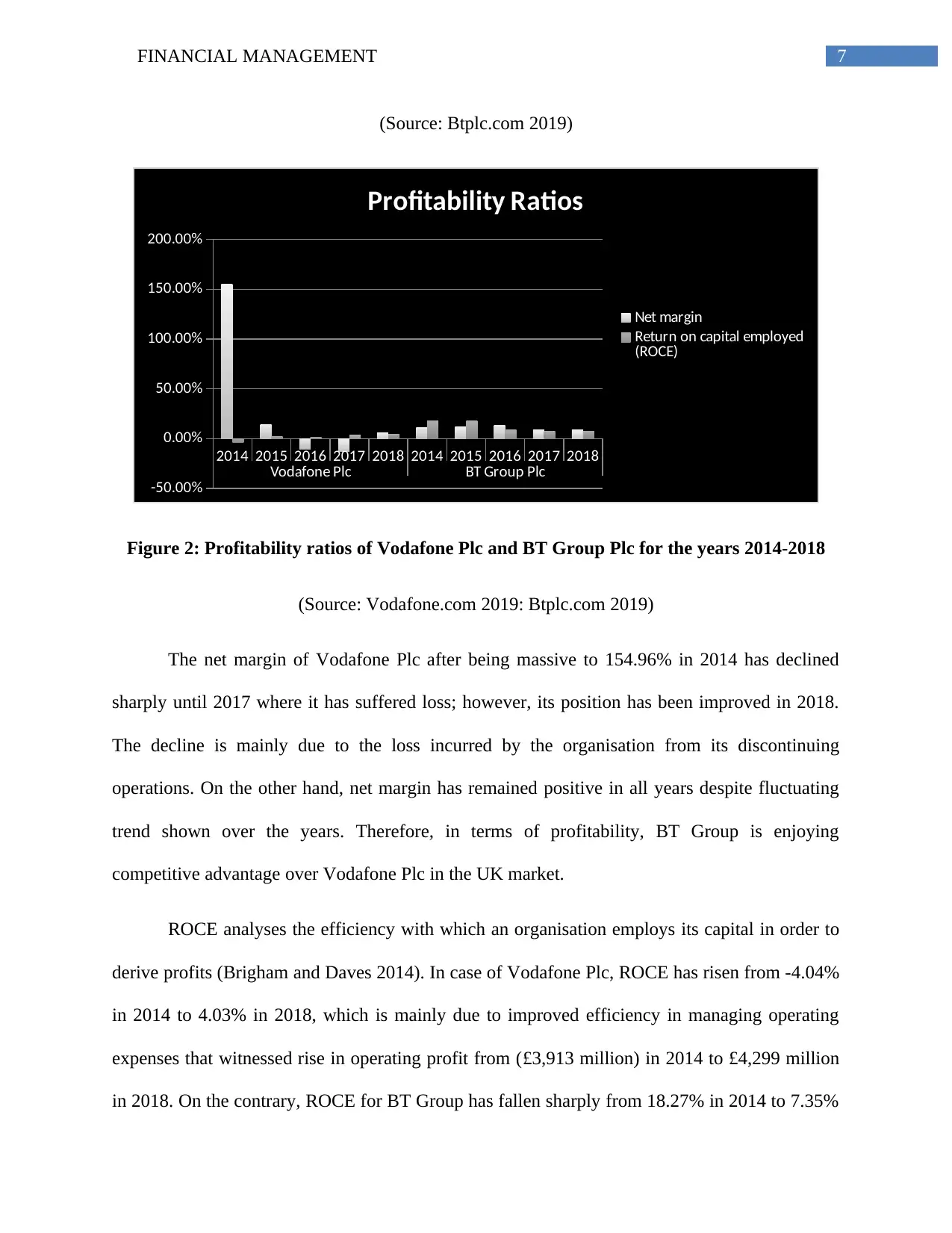
7FINANCIAL MANAGEMENT
(Source: Btplc.com 2019)
2014 2015 2016 2017 2018 2014 2015 2016 2017 2018
Vodafone Plc BT Group Plc
-50.00%
0.00%
50.00%
100.00%
150.00%
200.00%
Profitability Ratios
Net margin
Return on capital employed
(ROCE)
Figure 2: Profitability ratios of Vodafone Plc and BT Group Plc for the years 2014-2018
(Source: Vodafone.com 2019: Btplc.com 2019)
The net margin of Vodafone Plc after being massive to 154.96% in 2014 has declined
sharply until 2017 where it has suffered loss; however, its position has been improved in 2018.
The decline is mainly due to the loss incurred by the organisation from its discontinuing
operations. On the other hand, net margin has remained positive in all years despite fluctuating
trend shown over the years. Therefore, in terms of profitability, BT Group is enjoying
competitive advantage over Vodafone Plc in the UK market.
ROCE analyses the efficiency with which an organisation employs its capital in order to
derive profits (Brigham and Daves 2014). In case of Vodafone Plc, ROCE has risen from -4.04%
in 2014 to 4.03% in 2018, which is mainly due to improved efficiency in managing operating
expenses that witnessed rise in operating profit from (£3,913 million) in 2014 to £4,299 million
in 2018. On the contrary, ROCE for BT Group has fallen sharply from 18.27% in 2014 to 7.35%
(Source: Btplc.com 2019)
2014 2015 2016 2017 2018 2014 2015 2016 2017 2018
Vodafone Plc BT Group Plc
-50.00%
0.00%
50.00%
100.00%
150.00%
200.00%
Profitability Ratios
Net margin
Return on capital employed
(ROCE)
Figure 2: Profitability ratios of Vodafone Plc and BT Group Plc for the years 2014-2018
(Source: Vodafone.com 2019: Btplc.com 2019)
The net margin of Vodafone Plc after being massive to 154.96% in 2014 has declined
sharply until 2017 where it has suffered loss; however, its position has been improved in 2018.
The decline is mainly due to the loss incurred by the organisation from its discontinuing
operations. On the other hand, net margin has remained positive in all years despite fluctuating
trend shown over the years. Therefore, in terms of profitability, BT Group is enjoying
competitive advantage over Vodafone Plc in the UK market.
ROCE analyses the efficiency with which an organisation employs its capital in order to
derive profits (Brigham and Daves 2014). In case of Vodafone Plc, ROCE has risen from -4.04%
in 2014 to 4.03% in 2018, which is mainly due to improved efficiency in managing operating
expenses that witnessed rise in operating profit from (£3,913 million) in 2014 to £4,299 million
in 2018. On the contrary, ROCE for BT Group has fallen sharply from 18.27% in 2014 to 7.35%

8FINANCIAL MANAGEMENT
in 2018. However, the efficiency of Vodafone in using its capital is still lower compared to BT
Group Plc. Despite increased capital employed and higher revenue generated by Vodafone, its
operating income is suppressed owing to increased cost of sales and other operating expenses.
Thus, the profitability position of BT Group is found to be better than Vodafone Plc in the UK
telecommunications sector.
Efficiency analysis:
In order to conduct the efficiency analysis of Vodafone Plc and its competitor, BT Group
Plc, the three efficiency ratios that have been taken into account comprise of inventory turnover,
receivables turnover and payables turnover in terms of days, which are depicted as follows:
Table 5: Efficiency ratios of Vodafone Plc for the years 2014-2018
(Source: Vodafone.com 2019)
in 2018. However, the efficiency of Vodafone in using its capital is still lower compared to BT
Group Plc. Despite increased capital employed and higher revenue generated by Vodafone, its
operating income is suppressed owing to increased cost of sales and other operating expenses.
Thus, the profitability position of BT Group is found to be better than Vodafone Plc in the UK
telecommunications sector.
Efficiency analysis:
In order to conduct the efficiency analysis of Vodafone Plc and its competitor, BT Group
Plc, the three efficiency ratios that have been taken into account comprise of inventory turnover,
receivables turnover and payables turnover in terms of days, which are depicted as follows:
Table 5: Efficiency ratios of Vodafone Plc for the years 2014-2018
(Source: Vodafone.com 2019)
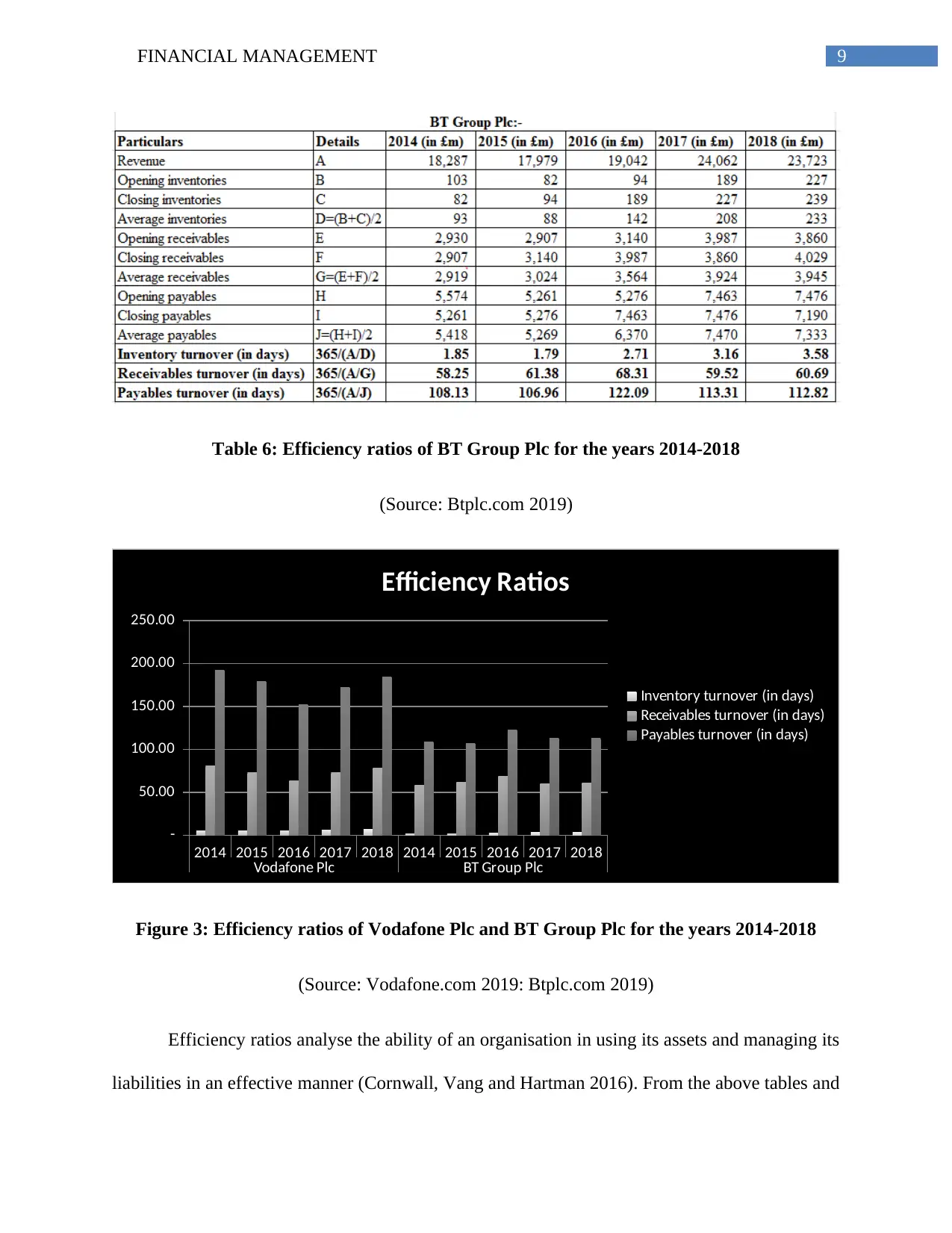
9FINANCIAL MANAGEMENT
Table 6: Efficiency ratios of BT Group Plc for the years 2014-2018
(Source: Btplc.com 2019)
2014 2015 2016 2017 2018 2014 2015 2016 2017 2018
Vodafone Plc BT Group Plc
-
50.00
100.00
150.00
200.00
250.00
Efficiency Ratios
Inventory turnover (in days)
Receivables turnover (in days)
Payables turnover (in days)
Figure 3: Efficiency ratios of Vodafone Plc and BT Group Plc for the years 2014-2018
(Source: Vodafone.com 2019: Btplc.com 2019)
Efficiency ratios analyse the ability of an organisation in using its assets and managing its
liabilities in an effective manner (Cornwall, Vang and Hartman 2016). From the above tables and
Table 6: Efficiency ratios of BT Group Plc for the years 2014-2018
(Source: Btplc.com 2019)
2014 2015 2016 2017 2018 2014 2015 2016 2017 2018
Vodafone Plc BT Group Plc
-
50.00
100.00
150.00
200.00
250.00
Efficiency Ratios
Inventory turnover (in days)
Receivables turnover (in days)
Payables turnover (in days)
Figure 3: Efficiency ratios of Vodafone Plc and BT Group Plc for the years 2014-2018
(Source: Vodafone.com 2019: Btplc.com 2019)
Efficiency ratios analyse the ability of an organisation in using its assets and managing its
liabilities in an effective manner (Cornwall, Vang and Hartman 2016). From the above tables and
Secure Best Marks with AI Grader
Need help grading? Try our AI Grader for instant feedback on your assignments.
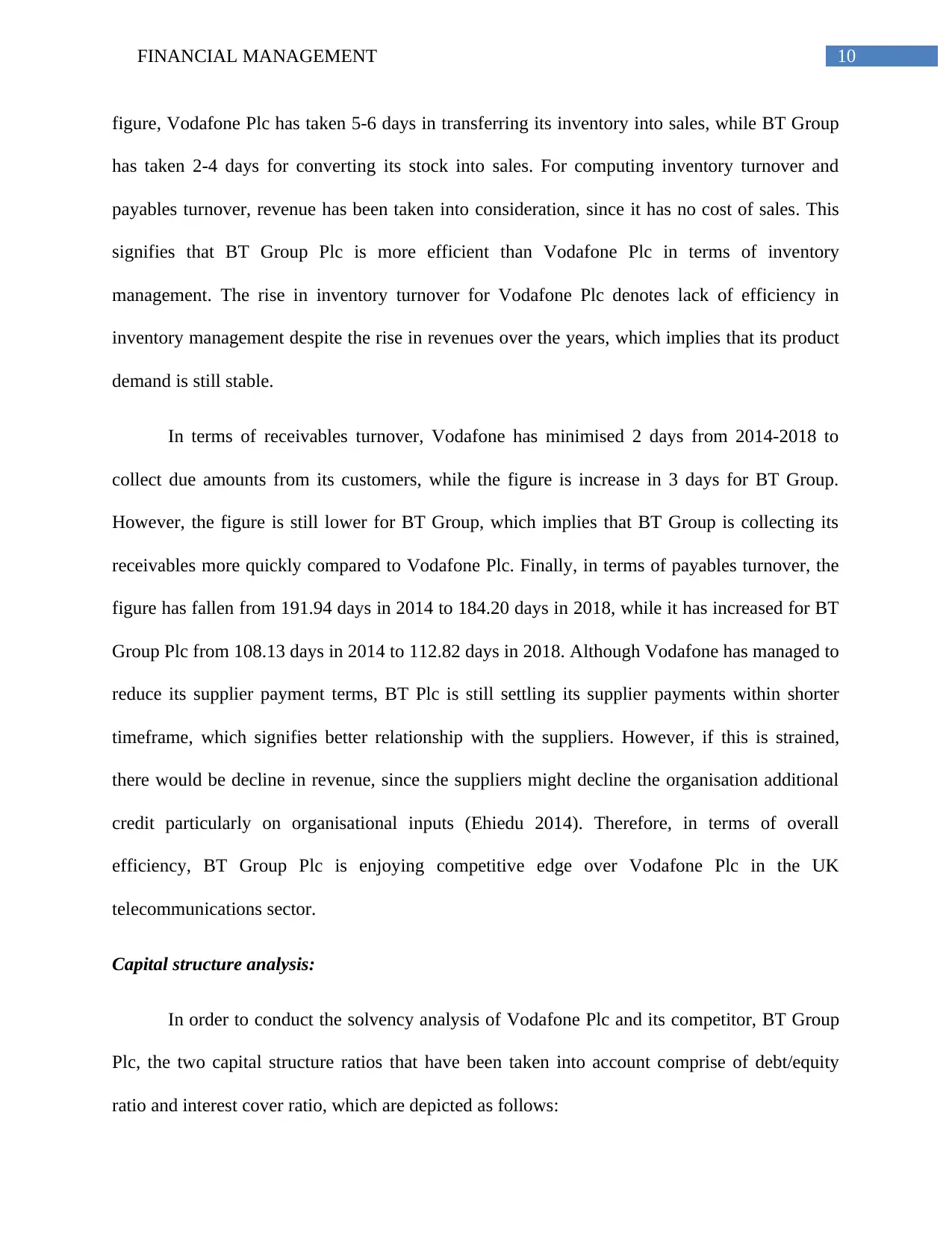
10FINANCIAL MANAGEMENT
figure, Vodafone Plc has taken 5-6 days in transferring its inventory into sales, while BT Group
has taken 2-4 days for converting its stock into sales. For computing inventory turnover and
payables turnover, revenue has been taken into consideration, since it has no cost of sales. This
signifies that BT Group Plc is more efficient than Vodafone Plc in terms of inventory
management. The rise in inventory turnover for Vodafone Plc denotes lack of efficiency in
inventory management despite the rise in revenues over the years, which implies that its product
demand is still stable.
In terms of receivables turnover, Vodafone has minimised 2 days from 2014-2018 to
collect due amounts from its customers, while the figure is increase in 3 days for BT Group.
However, the figure is still lower for BT Group, which implies that BT Group is collecting its
receivables more quickly compared to Vodafone Plc. Finally, in terms of payables turnover, the
figure has fallen from 191.94 days in 2014 to 184.20 days in 2018, while it has increased for BT
Group Plc from 108.13 days in 2014 to 112.82 days in 2018. Although Vodafone has managed to
reduce its supplier payment terms, BT Plc is still settling its supplier payments within shorter
timeframe, which signifies better relationship with the suppliers. However, if this is strained,
there would be decline in revenue, since the suppliers might decline the organisation additional
credit particularly on organisational inputs (Ehiedu 2014). Therefore, in terms of overall
efficiency, BT Group Plc is enjoying competitive edge over Vodafone Plc in the UK
telecommunications sector.
Capital structure analysis:
In order to conduct the solvency analysis of Vodafone Plc and its competitor, BT Group
Plc, the two capital structure ratios that have been taken into account comprise of debt/equity
ratio and interest cover ratio, which are depicted as follows:
figure, Vodafone Plc has taken 5-6 days in transferring its inventory into sales, while BT Group
has taken 2-4 days for converting its stock into sales. For computing inventory turnover and
payables turnover, revenue has been taken into consideration, since it has no cost of sales. This
signifies that BT Group Plc is more efficient than Vodafone Plc in terms of inventory
management. The rise in inventory turnover for Vodafone Plc denotes lack of efficiency in
inventory management despite the rise in revenues over the years, which implies that its product
demand is still stable.
In terms of receivables turnover, Vodafone has minimised 2 days from 2014-2018 to
collect due amounts from its customers, while the figure is increase in 3 days for BT Group.
However, the figure is still lower for BT Group, which implies that BT Group is collecting its
receivables more quickly compared to Vodafone Plc. Finally, in terms of payables turnover, the
figure has fallen from 191.94 days in 2014 to 184.20 days in 2018, while it has increased for BT
Group Plc from 108.13 days in 2014 to 112.82 days in 2018. Although Vodafone has managed to
reduce its supplier payment terms, BT Plc is still settling its supplier payments within shorter
timeframe, which signifies better relationship with the suppliers. However, if this is strained,
there would be decline in revenue, since the suppliers might decline the organisation additional
credit particularly on organisational inputs (Ehiedu 2014). Therefore, in terms of overall
efficiency, BT Group Plc is enjoying competitive edge over Vodafone Plc in the UK
telecommunications sector.
Capital structure analysis:
In order to conduct the solvency analysis of Vodafone Plc and its competitor, BT Group
Plc, the two capital structure ratios that have been taken into account comprise of debt/equity
ratio and interest cover ratio, which are depicted as follows:
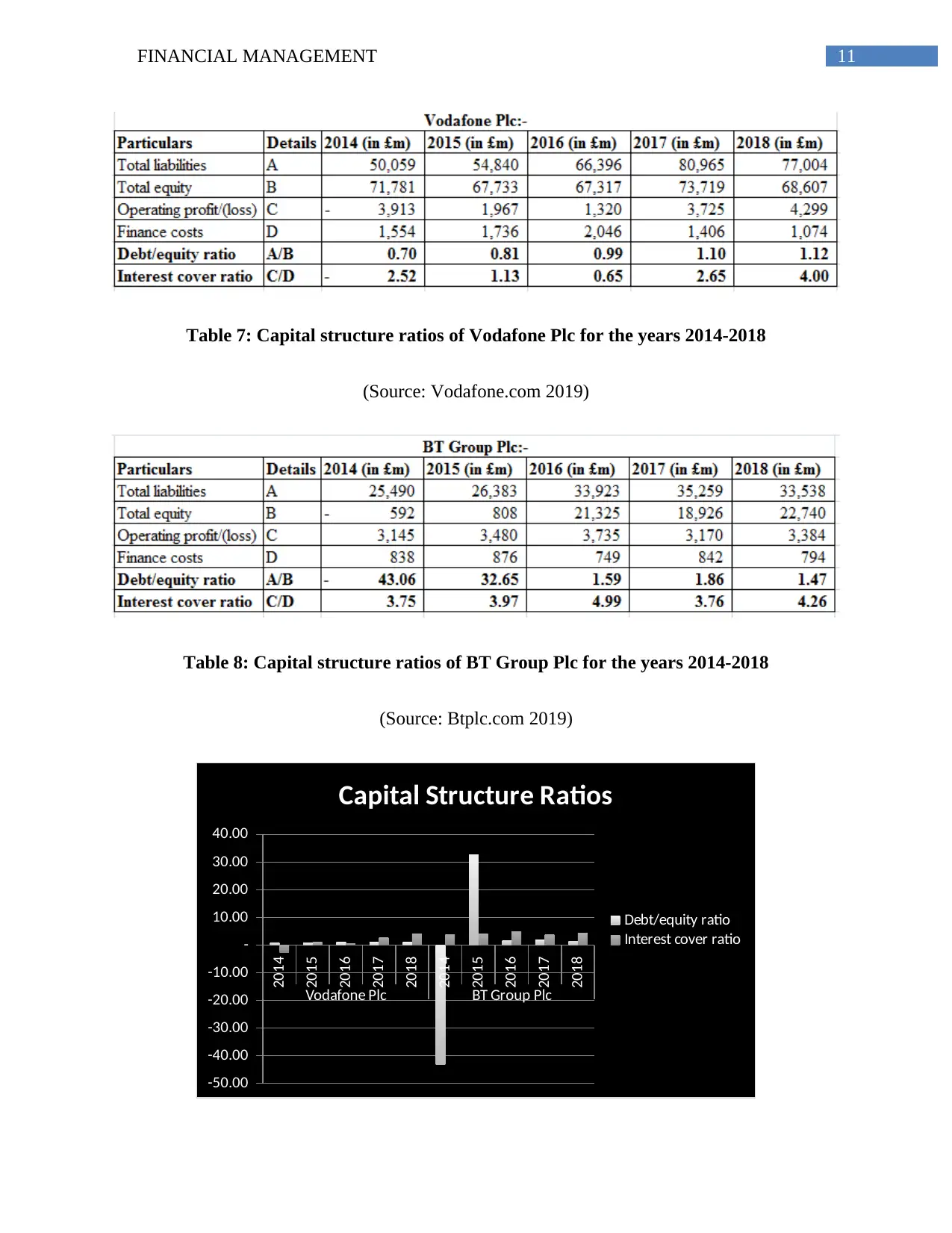
11FINANCIAL MANAGEMENT
Table 7: Capital structure ratios of Vodafone Plc for the years 2014-2018
(Source: Vodafone.com 2019)
Table 8: Capital structure ratios of BT Group Plc for the years 2014-2018
(Source: Btplc.com 2019)
2014
2015
2016
2017
2018
2014
2015
2016
2017
2018
Vodafone Plc BT Group Plc
-50.00
-40.00
-30.00
-20.00
-10.00
-
10.00
20.00
30.00
40.00
Capital Structure Ratios
Debt/equity ratio
Interest cover ratio
Table 7: Capital structure ratios of Vodafone Plc for the years 2014-2018
(Source: Vodafone.com 2019)
Table 8: Capital structure ratios of BT Group Plc for the years 2014-2018
(Source: Btplc.com 2019)
2014
2015
2016
2017
2018
2014
2015
2016
2017
2018
Vodafone Plc BT Group Plc
-50.00
-40.00
-30.00
-20.00
-10.00
-
10.00
20.00
30.00
40.00
Capital Structure Ratios
Debt/equity ratio
Interest cover ratio
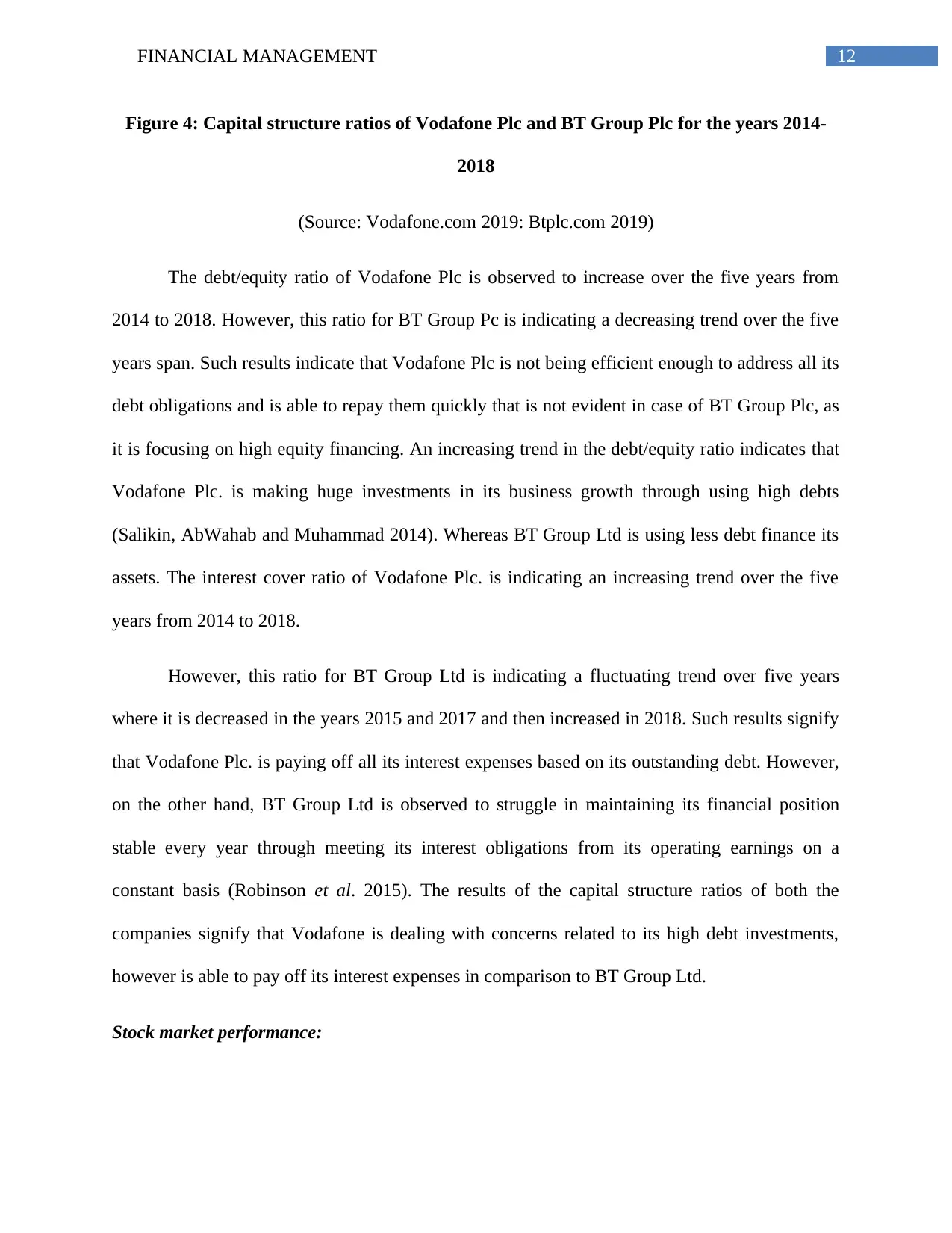
12FINANCIAL MANAGEMENT
Figure 4: Capital structure ratios of Vodafone Plc and BT Group Plc for the years 2014-
2018
(Source: Vodafone.com 2019: Btplc.com 2019)
The debt/equity ratio of Vodafone Plc is observed to increase over the five years from
2014 to 2018. However, this ratio for BT Group Pc is indicating a decreasing trend over the five
years span. Such results indicate that Vodafone Plc is not being efficient enough to address all its
debt obligations and is able to repay them quickly that is not evident in case of BT Group Plc, as
it is focusing on high equity financing. An increasing trend in the debt/equity ratio indicates that
Vodafone Plc. is making huge investments in its business growth through using high debts
(Salikin, AbWahab and Muhammad 2014). Whereas BT Group Ltd is using less debt finance its
assets. The interest cover ratio of Vodafone Plc. is indicating an increasing trend over the five
years from 2014 to 2018.
However, this ratio for BT Group Ltd is indicating a fluctuating trend over five years
where it is decreased in the years 2015 and 2017 and then increased in 2018. Such results signify
that Vodafone Plc. is paying off all its interest expenses based on its outstanding debt. However,
on the other hand, BT Group Ltd is observed to struggle in maintaining its financial position
stable every year through meeting its interest obligations from its operating earnings on a
constant basis (Robinson et al. 2015). The results of the capital structure ratios of both the
companies signify that Vodafone is dealing with concerns related to its high debt investments,
however is able to pay off its interest expenses in comparison to BT Group Ltd.
Stock market performance:
Figure 4: Capital structure ratios of Vodafone Plc and BT Group Plc for the years 2014-
2018
(Source: Vodafone.com 2019: Btplc.com 2019)
The debt/equity ratio of Vodafone Plc is observed to increase over the five years from
2014 to 2018. However, this ratio for BT Group Pc is indicating a decreasing trend over the five
years span. Such results indicate that Vodafone Plc is not being efficient enough to address all its
debt obligations and is able to repay them quickly that is not evident in case of BT Group Plc, as
it is focusing on high equity financing. An increasing trend in the debt/equity ratio indicates that
Vodafone Plc. is making huge investments in its business growth through using high debts
(Salikin, AbWahab and Muhammad 2014). Whereas BT Group Ltd is using less debt finance its
assets. The interest cover ratio of Vodafone Plc. is indicating an increasing trend over the five
years from 2014 to 2018.
However, this ratio for BT Group Ltd is indicating a fluctuating trend over five years
where it is decreased in the years 2015 and 2017 and then increased in 2018. Such results signify
that Vodafone Plc. is paying off all its interest expenses based on its outstanding debt. However,
on the other hand, BT Group Ltd is observed to struggle in maintaining its financial position
stable every year through meeting its interest obligations from its operating earnings on a
constant basis (Robinson et al. 2015). The results of the capital structure ratios of both the
companies signify that Vodafone is dealing with concerns related to its high debt investments,
however is able to pay off its interest expenses in comparison to BT Group Ltd.
Stock market performance:
Paraphrase This Document
Need a fresh take? Get an instant paraphrase of this document with our AI Paraphraser
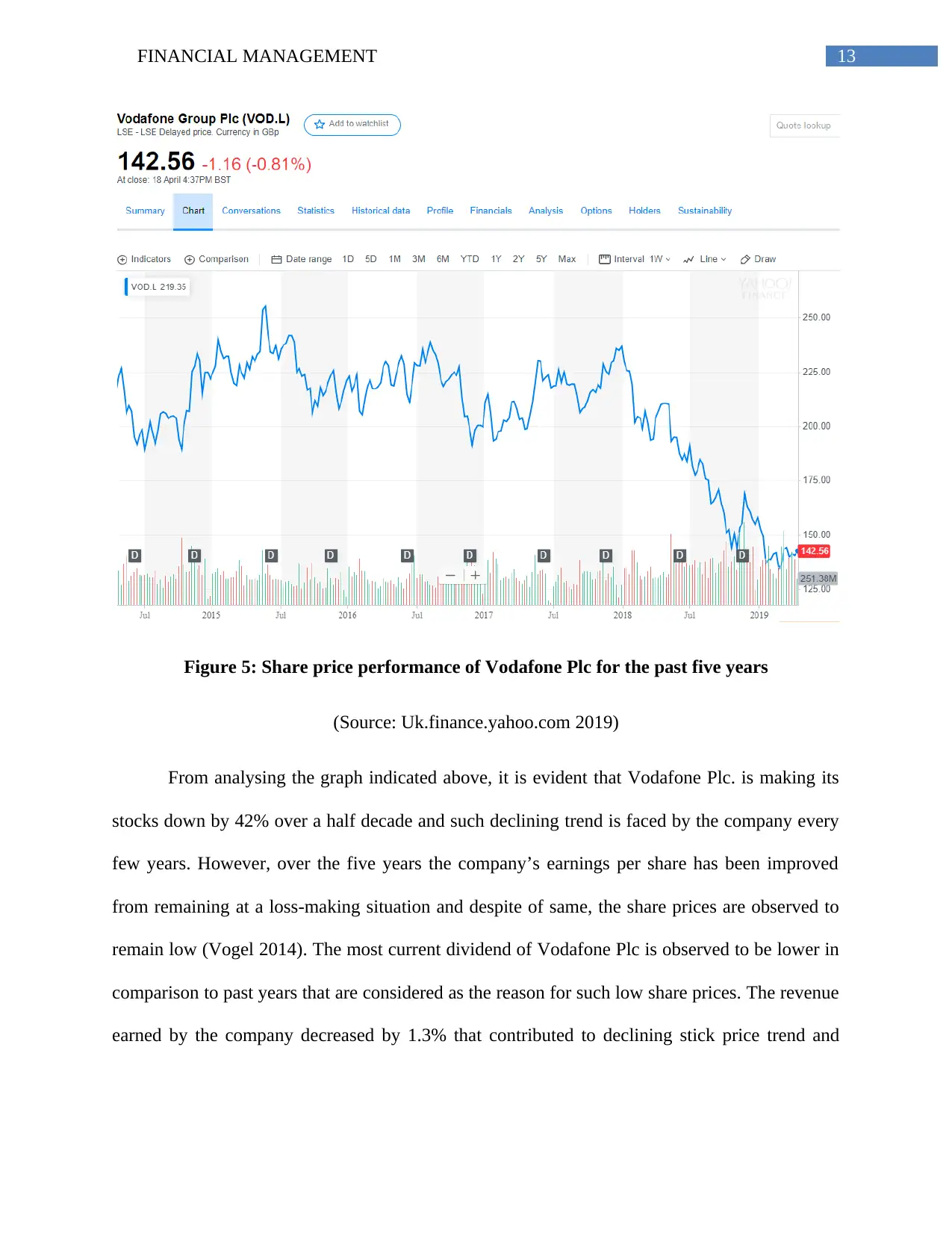
13FINANCIAL MANAGEMENT
Figure 5: Share price performance of Vodafone Plc for the past five years
(Source: Uk.finance.yahoo.com 2019)
From analysing the graph indicated above, it is evident that Vodafone Plc. is making its
stocks down by 42% over a half decade and such declining trend is faced by the company every
few years. However, over the five years the company’s earnings per share has been improved
from remaining at a loss-making situation and despite of same, the share prices are observed to
remain low (Vogel 2014). The most current dividend of Vodafone Plc is observed to be lower in
comparison to past years that are considered as the reason for such low share prices. The revenue
earned by the company decreased by 1.3% that contributed to declining stick price trend and
Figure 5: Share price performance of Vodafone Plc for the past five years
(Source: Uk.finance.yahoo.com 2019)
From analysing the graph indicated above, it is evident that Vodafone Plc. is making its
stocks down by 42% over a half decade and such declining trend is faced by the company every
few years. However, over the five years the company’s earnings per share has been improved
from remaining at a loss-making situation and despite of same, the share prices are observed to
remain low (Vogel 2014). The most current dividend of Vodafone Plc is observed to be lower in
comparison to past years that are considered as the reason for such low share prices. The revenue
earned by the company decreased by 1.3% that contributed to declining stick price trend and
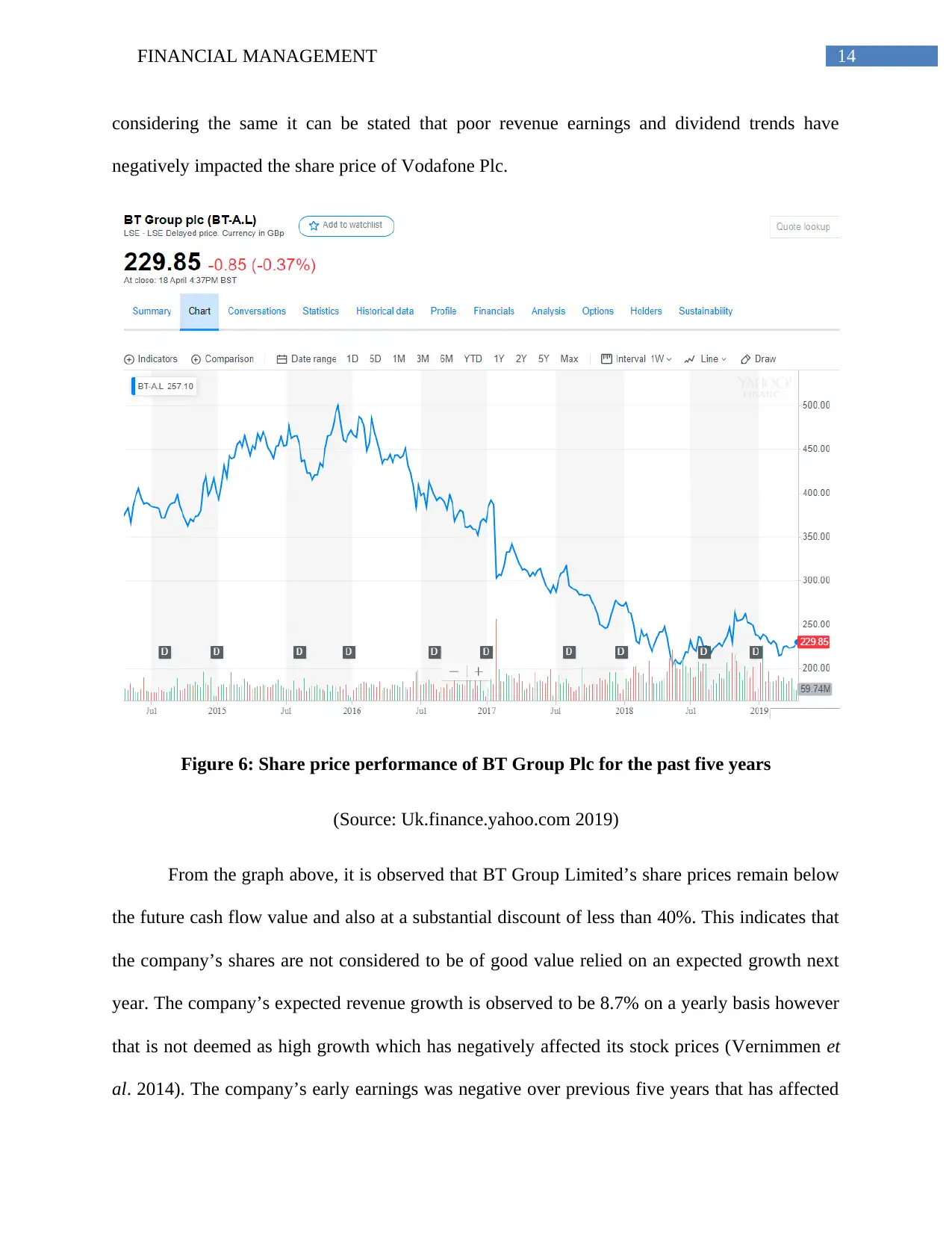
14FINANCIAL MANAGEMENT
considering the same it can be stated that poor revenue earnings and dividend trends have
negatively impacted the share price of Vodafone Plc.
Figure 6: Share price performance of BT Group Plc for the past five years
(Source: Uk.finance.yahoo.com 2019)
From the graph above, it is observed that BT Group Limited’s share prices remain below
the future cash flow value and also at a substantial discount of less than 40%. This indicates that
the company’s shares are not considered to be of good value relied on an expected growth next
year. The company’s expected revenue growth is observed to be 8.7% on a yearly basis however
that is not deemed as high growth which has negatively affected its stock prices (Vernimmen et
al. 2014). The company’s early earnings was negative over previous five years that has affected
considering the same it can be stated that poor revenue earnings and dividend trends have
negatively impacted the share price of Vodafone Plc.
Figure 6: Share price performance of BT Group Plc for the past five years
(Source: Uk.finance.yahoo.com 2019)
From the graph above, it is observed that BT Group Limited’s share prices remain below
the future cash flow value and also at a substantial discount of less than 40%. This indicates that
the company’s shares are not considered to be of good value relied on an expected growth next
year. The company’s expected revenue growth is observed to be 8.7% on a yearly basis however
that is not deemed as high growth which has negatively affected its stock prices (Vernimmen et
al. 2014). The company’s early earnings was negative over previous five years that has affected
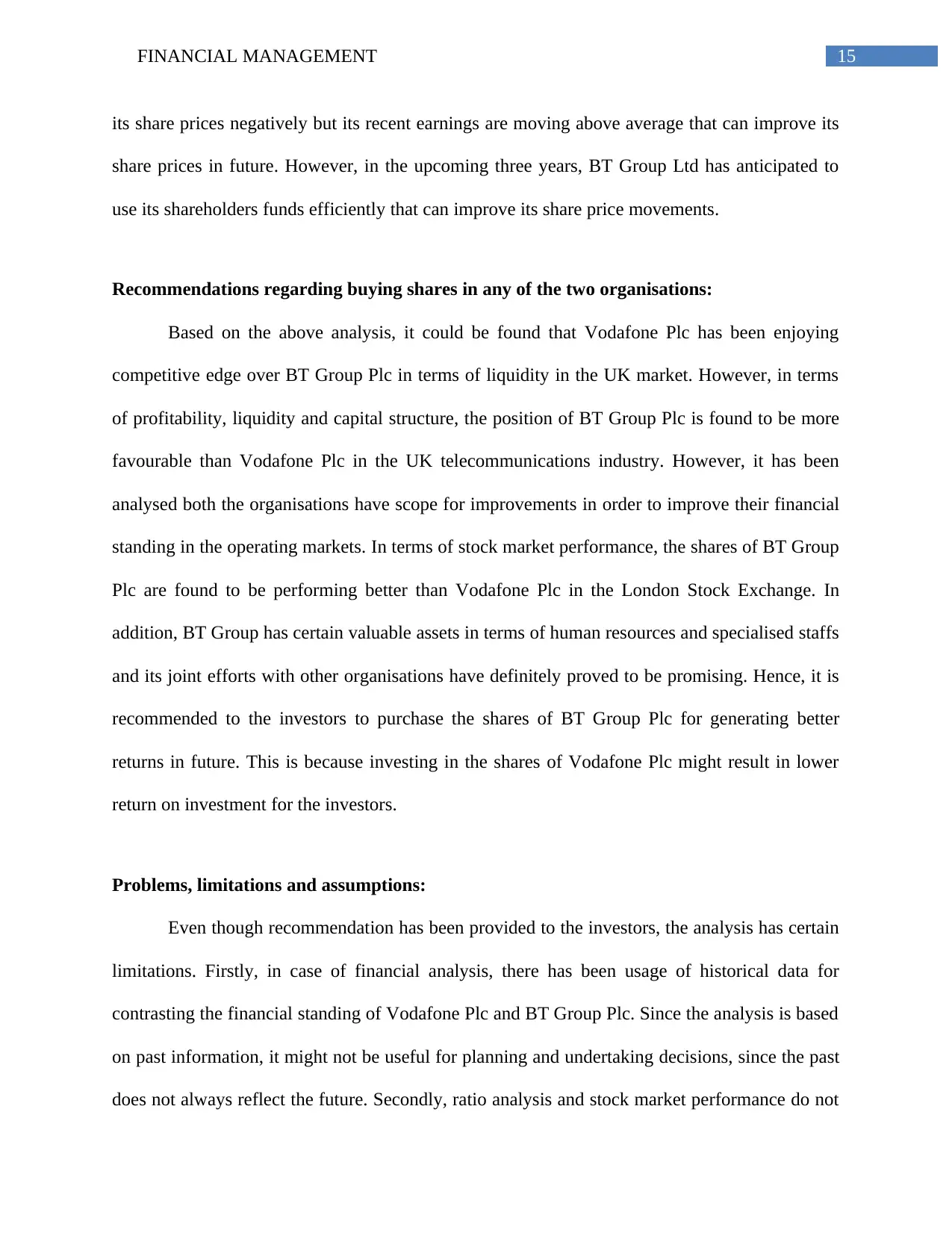
15FINANCIAL MANAGEMENT
its share prices negatively but its recent earnings are moving above average that can improve its
share prices in future. However, in the upcoming three years, BT Group Ltd has anticipated to
use its shareholders funds efficiently that can improve its share price movements.
Recommendations regarding buying shares in any of the two organisations:
Based on the above analysis, it could be found that Vodafone Plc has been enjoying
competitive edge over BT Group Plc in terms of liquidity in the UK market. However, in terms
of profitability, liquidity and capital structure, the position of BT Group Plc is found to be more
favourable than Vodafone Plc in the UK telecommunications industry. However, it has been
analysed both the organisations have scope for improvements in order to improve their financial
standing in the operating markets. In terms of stock market performance, the shares of BT Group
Plc are found to be performing better than Vodafone Plc in the London Stock Exchange. In
addition, BT Group has certain valuable assets in terms of human resources and specialised staffs
and its joint efforts with other organisations have definitely proved to be promising. Hence, it is
recommended to the investors to purchase the shares of BT Group Plc for generating better
returns in future. This is because investing in the shares of Vodafone Plc might result in lower
return on investment for the investors.
Problems, limitations and assumptions:
Even though recommendation has been provided to the investors, the analysis has certain
limitations. Firstly, in case of financial analysis, there has been usage of historical data for
contrasting the financial standing of Vodafone Plc and BT Group Plc. Since the analysis is based
on past information, it might not be useful for planning and undertaking decisions, since the past
does not always reflect the future. Secondly, ratio analysis and stock market performance do not
its share prices negatively but its recent earnings are moving above average that can improve its
share prices in future. However, in the upcoming three years, BT Group Ltd has anticipated to
use its shareholders funds efficiently that can improve its share price movements.
Recommendations regarding buying shares in any of the two organisations:
Based on the above analysis, it could be found that Vodafone Plc has been enjoying
competitive edge over BT Group Plc in terms of liquidity in the UK market. However, in terms
of profitability, liquidity and capital structure, the position of BT Group Plc is found to be more
favourable than Vodafone Plc in the UK telecommunications industry. However, it has been
analysed both the organisations have scope for improvements in order to improve their financial
standing in the operating markets. In terms of stock market performance, the shares of BT Group
Plc are found to be performing better than Vodafone Plc in the London Stock Exchange. In
addition, BT Group has certain valuable assets in terms of human resources and specialised staffs
and its joint efforts with other organisations have definitely proved to be promising. Hence, it is
recommended to the investors to purchase the shares of BT Group Plc for generating better
returns in future. This is because investing in the shares of Vodafone Plc might result in lower
return on investment for the investors.
Problems, limitations and assumptions:
Even though recommendation has been provided to the investors, the analysis has certain
limitations. Firstly, in case of financial analysis, there has been usage of historical data for
contrasting the financial standing of Vodafone Plc and BT Group Plc. Since the analysis is based
on past information, it might not be useful for planning and undertaking decisions, since the past
does not always reflect the future. Secondly, ratio analysis and stock market performance do not
Secure Best Marks with AI Grader
Need help grading? Try our AI Grader for instant feedback on your assignments.
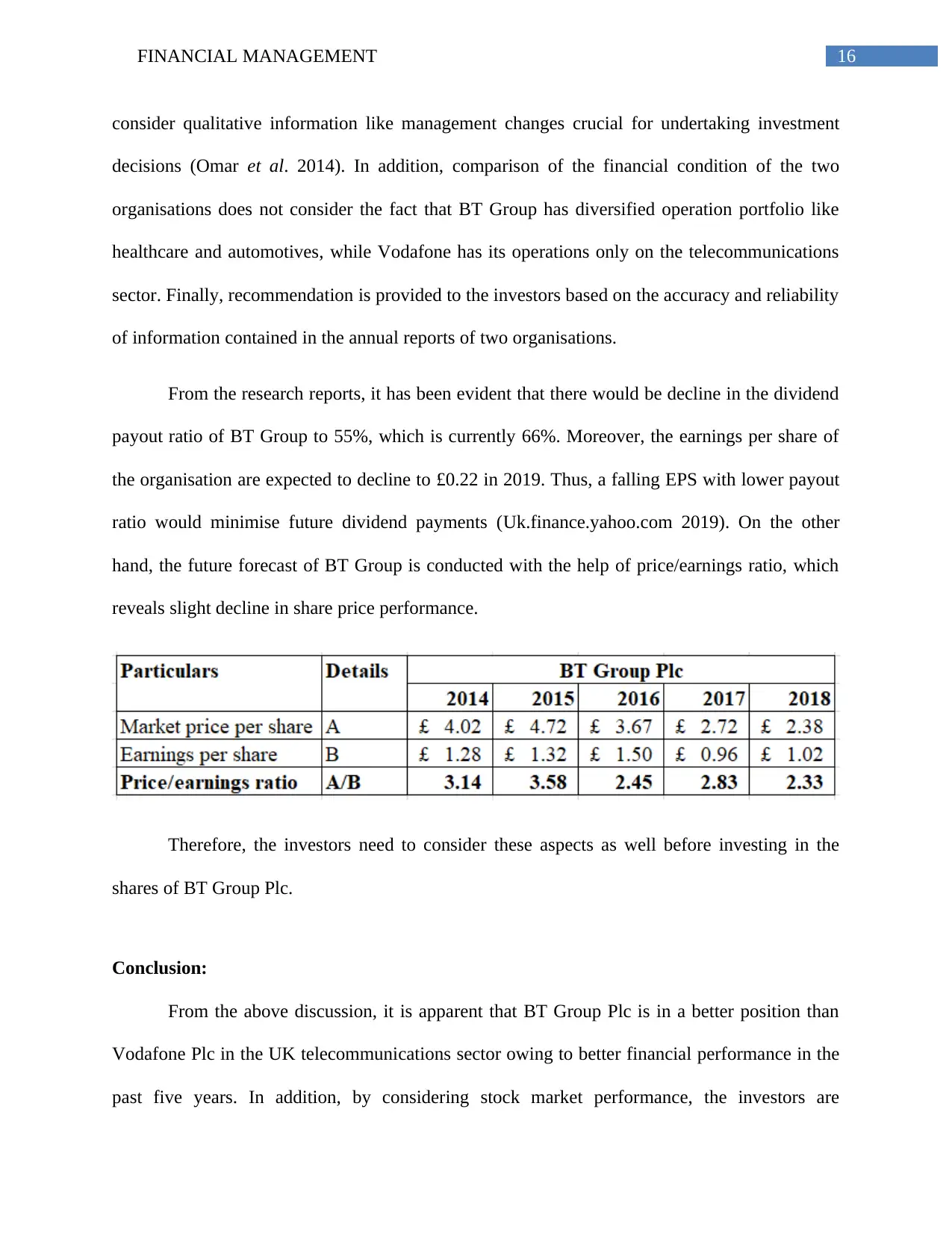
16FINANCIAL MANAGEMENT
consider qualitative information like management changes crucial for undertaking investment
decisions (Omar et al. 2014). In addition, comparison of the financial condition of the two
organisations does not consider the fact that BT Group has diversified operation portfolio like
healthcare and automotives, while Vodafone has its operations only on the telecommunications
sector. Finally, recommendation is provided to the investors based on the accuracy and reliability
of information contained in the annual reports of two organisations.
From the research reports, it has been evident that there would be decline in the dividend
payout ratio of BT Group to 55%, which is currently 66%. Moreover, the earnings per share of
the organisation are expected to decline to £0.22 in 2019. Thus, a falling EPS with lower payout
ratio would minimise future dividend payments (Uk.finance.yahoo.com 2019). On the other
hand, the future forecast of BT Group is conducted with the help of price/earnings ratio, which
reveals slight decline in share price performance.
Therefore, the investors need to consider these aspects as well before investing in the
shares of BT Group Plc.
Conclusion:
From the above discussion, it is apparent that BT Group Plc is in a better position than
Vodafone Plc in the UK telecommunications sector owing to better financial performance in the
past five years. In addition, by considering stock market performance, the investors are
consider qualitative information like management changes crucial for undertaking investment
decisions (Omar et al. 2014). In addition, comparison of the financial condition of the two
organisations does not consider the fact that BT Group has diversified operation portfolio like
healthcare and automotives, while Vodafone has its operations only on the telecommunications
sector. Finally, recommendation is provided to the investors based on the accuracy and reliability
of information contained in the annual reports of two organisations.
From the research reports, it has been evident that there would be decline in the dividend
payout ratio of BT Group to 55%, which is currently 66%. Moreover, the earnings per share of
the organisation are expected to decline to £0.22 in 2019. Thus, a falling EPS with lower payout
ratio would minimise future dividend payments (Uk.finance.yahoo.com 2019). On the other
hand, the future forecast of BT Group is conducted with the help of price/earnings ratio, which
reveals slight decline in share price performance.
Therefore, the investors need to consider these aspects as well before investing in the
shares of BT Group Plc.
Conclusion:
From the above discussion, it is apparent that BT Group Plc is in a better position than
Vodafone Plc in the UK telecommunications sector owing to better financial performance in the
past five years. In addition, by considering stock market performance, the investors are
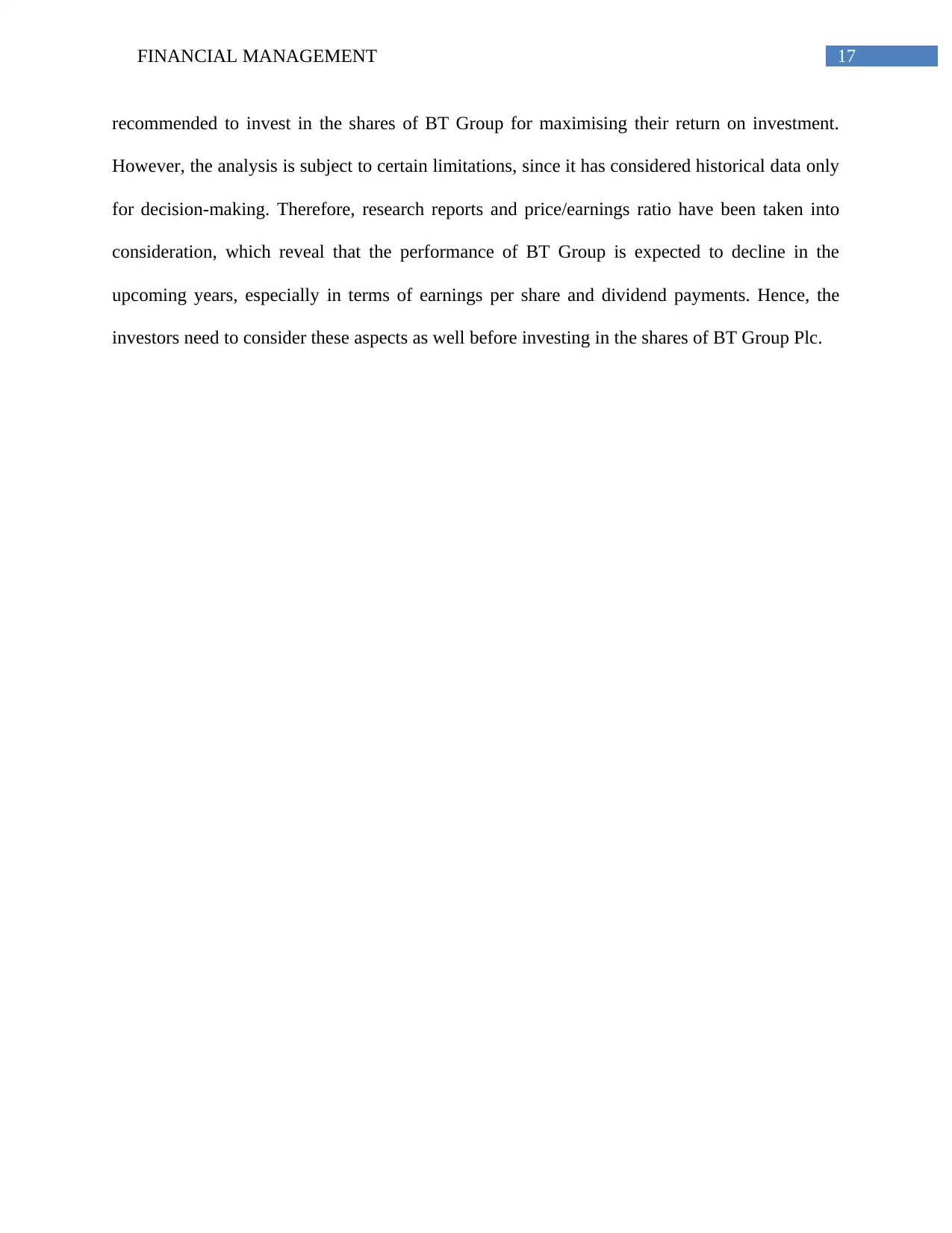
17FINANCIAL MANAGEMENT
recommended to invest in the shares of BT Group for maximising their return on investment.
However, the analysis is subject to certain limitations, since it has considered historical data only
for decision-making. Therefore, research reports and price/earnings ratio have been taken into
consideration, which reveal that the performance of BT Group is expected to decline in the
upcoming years, especially in terms of earnings per share and dividend payments. Hence, the
investors need to consider these aspects as well before investing in the shares of BT Group Plc.
recommended to invest in the shares of BT Group for maximising their return on investment.
However, the analysis is subject to certain limitations, since it has considered historical data only
for decision-making. Therefore, research reports and price/earnings ratio have been taken into
consideration, which reveal that the performance of BT Group is expected to decline in the
upcoming years, especially in terms of earnings per share and dividend payments. Hence, the
investors need to consider these aspects as well before investing in the shares of BT Group Plc.
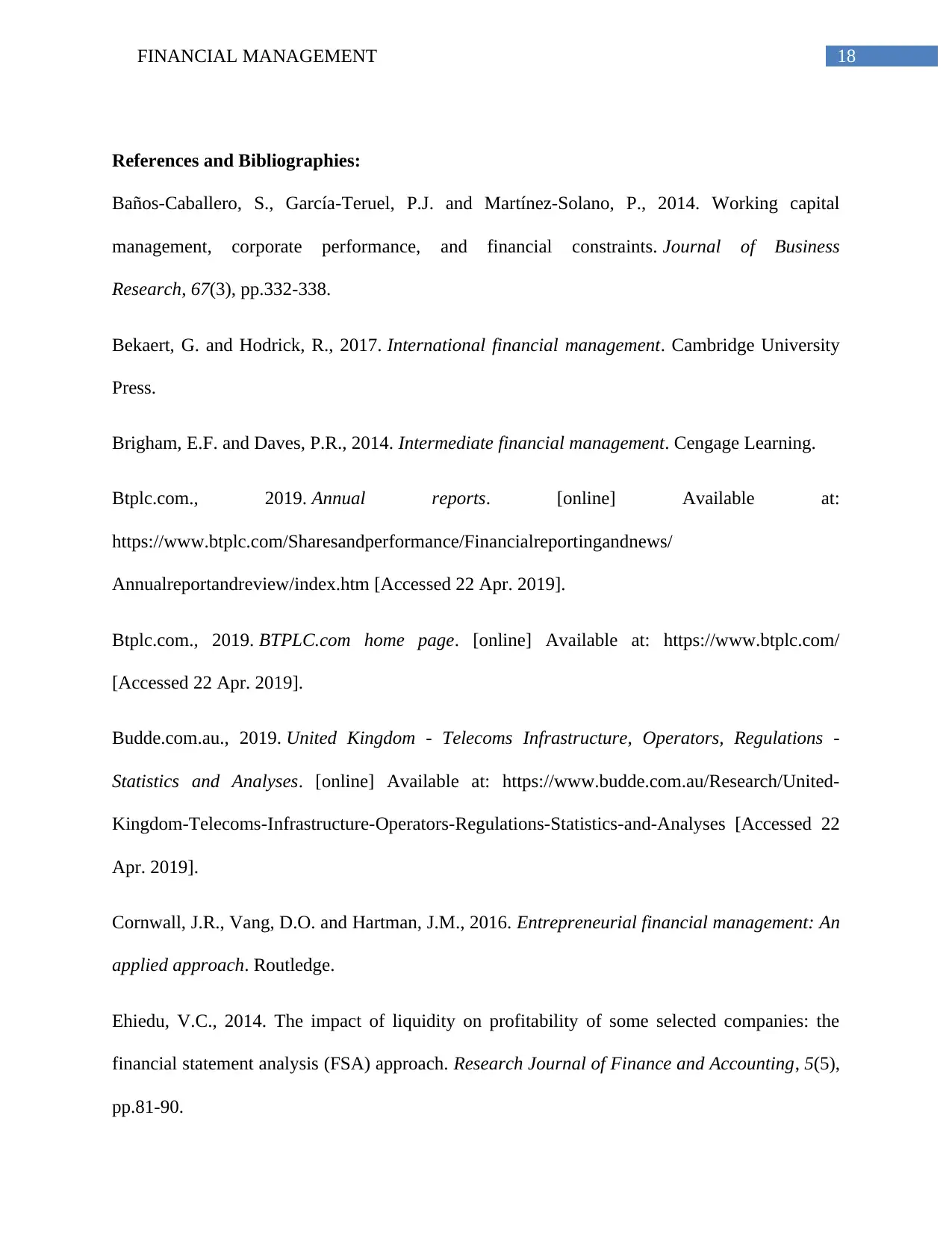
18FINANCIAL MANAGEMENT
References and Bibliographies:
Baños-Caballero, S., García-Teruel, P.J. and Martínez-Solano, P., 2014. Working capital
management, corporate performance, and financial constraints. Journal of Business
Research, 67(3), pp.332-338.
Bekaert, G. and Hodrick, R., 2017. International financial management. Cambridge University
Press.
Brigham, E.F. and Daves, P.R., 2014. Intermediate financial management. Cengage Learning.
Btplc.com., 2019. Annual reports. [online] Available at:
https://www.btplc.com/Sharesandperformance/Financialreportingandnews/
Annualreportandreview/index.htm [Accessed 22 Apr. 2019].
Btplc.com., 2019. BTPLC.com home page. [online] Available at: https://www.btplc.com/
[Accessed 22 Apr. 2019].
Budde.com.au., 2019. United Kingdom - Telecoms Infrastructure, Operators, Regulations -
Statistics and Analyses. [online] Available at: https://www.budde.com.au/Research/United-
Kingdom-Telecoms-Infrastructure-Operators-Regulations-Statistics-and-Analyses [Accessed 22
Apr. 2019].
Cornwall, J.R., Vang, D.O. and Hartman, J.M., 2016. Entrepreneurial financial management: An
applied approach. Routledge.
Ehiedu, V.C., 2014. The impact of liquidity on profitability of some selected companies: the
financial statement analysis (FSA) approach. Research Journal of Finance and Accounting, 5(5),
pp.81-90.
References and Bibliographies:
Baños-Caballero, S., García-Teruel, P.J. and Martínez-Solano, P., 2014. Working capital
management, corporate performance, and financial constraints. Journal of Business
Research, 67(3), pp.332-338.
Bekaert, G. and Hodrick, R., 2017. International financial management. Cambridge University
Press.
Brigham, E.F. and Daves, P.R., 2014. Intermediate financial management. Cengage Learning.
Btplc.com., 2019. Annual reports. [online] Available at:
https://www.btplc.com/Sharesandperformance/Financialreportingandnews/
Annualreportandreview/index.htm [Accessed 22 Apr. 2019].
Btplc.com., 2019. BTPLC.com home page. [online] Available at: https://www.btplc.com/
[Accessed 22 Apr. 2019].
Budde.com.au., 2019. United Kingdom - Telecoms Infrastructure, Operators, Regulations -
Statistics and Analyses. [online] Available at: https://www.budde.com.au/Research/United-
Kingdom-Telecoms-Infrastructure-Operators-Regulations-Statistics-and-Analyses [Accessed 22
Apr. 2019].
Cornwall, J.R., Vang, D.O. and Hartman, J.M., 2016. Entrepreneurial financial management: An
applied approach. Routledge.
Ehiedu, V.C., 2014. The impact of liquidity on profitability of some selected companies: the
financial statement analysis (FSA) approach. Research Journal of Finance and Accounting, 5(5),
pp.81-90.
Paraphrase This Document
Need a fresh take? Get an instant paraphrase of this document with our AI Paraphraser
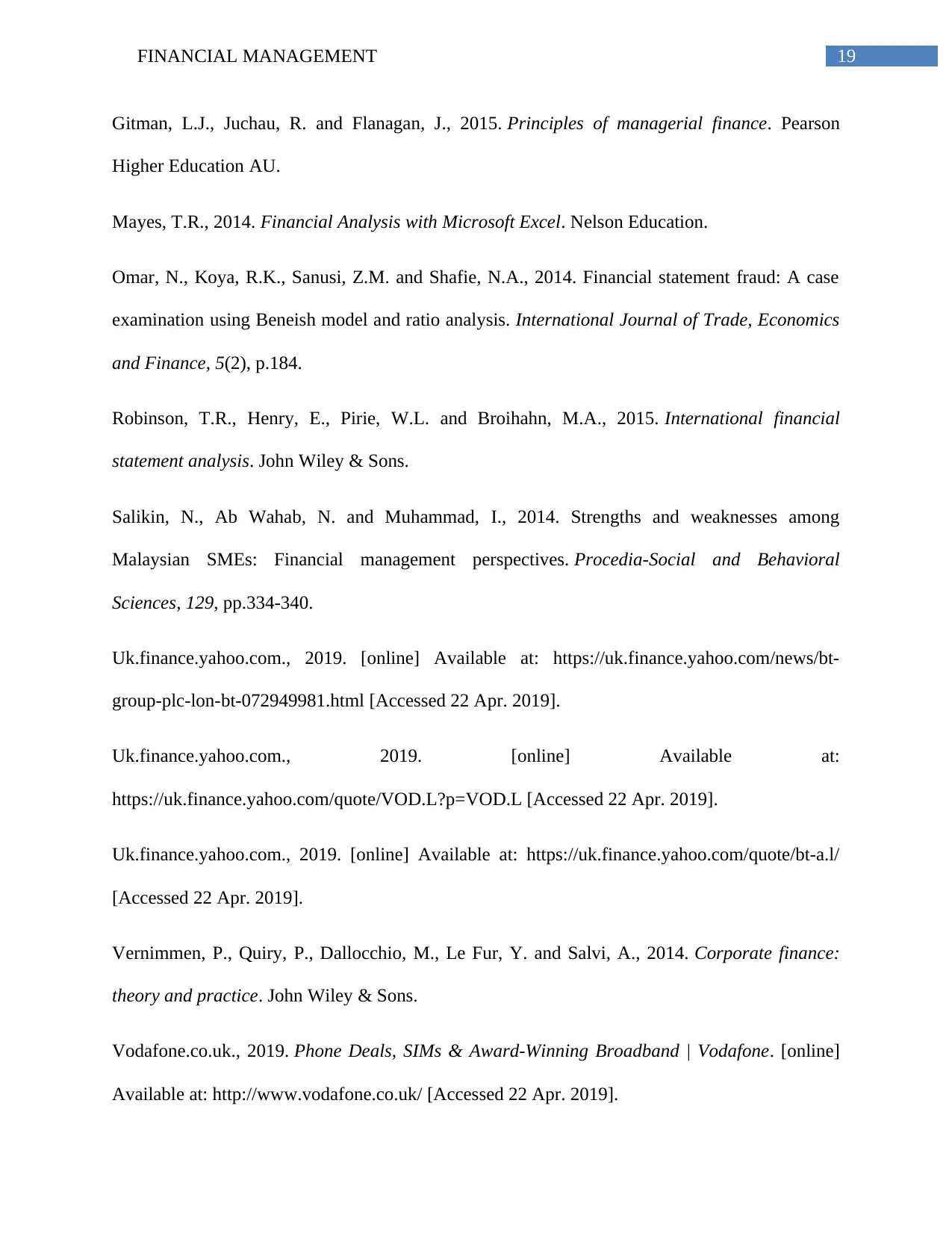
19FINANCIAL MANAGEMENT
Gitman, L.J., Juchau, R. and Flanagan, J., 2015. Principles of managerial finance. Pearson
Higher Education AU.
Mayes, T.R., 2014. Financial Analysis with Microsoft Excel. Nelson Education.
Omar, N., Koya, R.K., Sanusi, Z.M. and Shafie, N.A., 2014. Financial statement fraud: A case
examination using Beneish model and ratio analysis. International Journal of Trade, Economics
and Finance, 5(2), p.184.
Robinson, T.R., Henry, E., Pirie, W.L. and Broihahn, M.A., 2015. International financial
statement analysis. John Wiley & Sons.
Salikin, N., Ab Wahab, N. and Muhammad, I., 2014. Strengths and weaknesses among
Malaysian SMEs: Financial management perspectives. Procedia-Social and Behavioral
Sciences, 129, pp.334-340.
Uk.finance.yahoo.com., 2019. [online] Available at: https://uk.finance.yahoo.com/news/bt-
group-plc-lon-bt-072949981.html [Accessed 22 Apr. 2019].
Uk.finance.yahoo.com., 2019. [online] Available at:
https://uk.finance.yahoo.com/quote/VOD.L?p=VOD.L [Accessed 22 Apr. 2019].
Uk.finance.yahoo.com., 2019. [online] Available at: https://uk.finance.yahoo.com/quote/bt-a.l/
[Accessed 22 Apr. 2019].
Vernimmen, P., Quiry, P., Dallocchio, M., Le Fur, Y. and Salvi, A., 2014. Corporate finance:
theory and practice. John Wiley & Sons.
Vodafone.co.uk., 2019. Phone Deals, SIMs & Award-Winning Broadband | Vodafone. [online]
Available at: http://www.vodafone.co.uk/ [Accessed 22 Apr. 2019].
Gitman, L.J., Juchau, R. and Flanagan, J., 2015. Principles of managerial finance. Pearson
Higher Education AU.
Mayes, T.R., 2014. Financial Analysis with Microsoft Excel. Nelson Education.
Omar, N., Koya, R.K., Sanusi, Z.M. and Shafie, N.A., 2014. Financial statement fraud: A case
examination using Beneish model and ratio analysis. International Journal of Trade, Economics
and Finance, 5(2), p.184.
Robinson, T.R., Henry, E., Pirie, W.L. and Broihahn, M.A., 2015. International financial
statement analysis. John Wiley & Sons.
Salikin, N., Ab Wahab, N. and Muhammad, I., 2014. Strengths and weaknesses among
Malaysian SMEs: Financial management perspectives. Procedia-Social and Behavioral
Sciences, 129, pp.334-340.
Uk.finance.yahoo.com., 2019. [online] Available at: https://uk.finance.yahoo.com/news/bt-
group-plc-lon-bt-072949981.html [Accessed 22 Apr. 2019].
Uk.finance.yahoo.com., 2019. [online] Available at:
https://uk.finance.yahoo.com/quote/VOD.L?p=VOD.L [Accessed 22 Apr. 2019].
Uk.finance.yahoo.com., 2019. [online] Available at: https://uk.finance.yahoo.com/quote/bt-a.l/
[Accessed 22 Apr. 2019].
Vernimmen, P., Quiry, P., Dallocchio, M., Le Fur, Y. and Salvi, A., 2014. Corporate finance:
theory and practice. John Wiley & Sons.
Vodafone.co.uk., 2019. Phone Deals, SIMs & Award-Winning Broadband | Vodafone. [online]
Available at: http://www.vodafone.co.uk/ [Accessed 22 Apr. 2019].
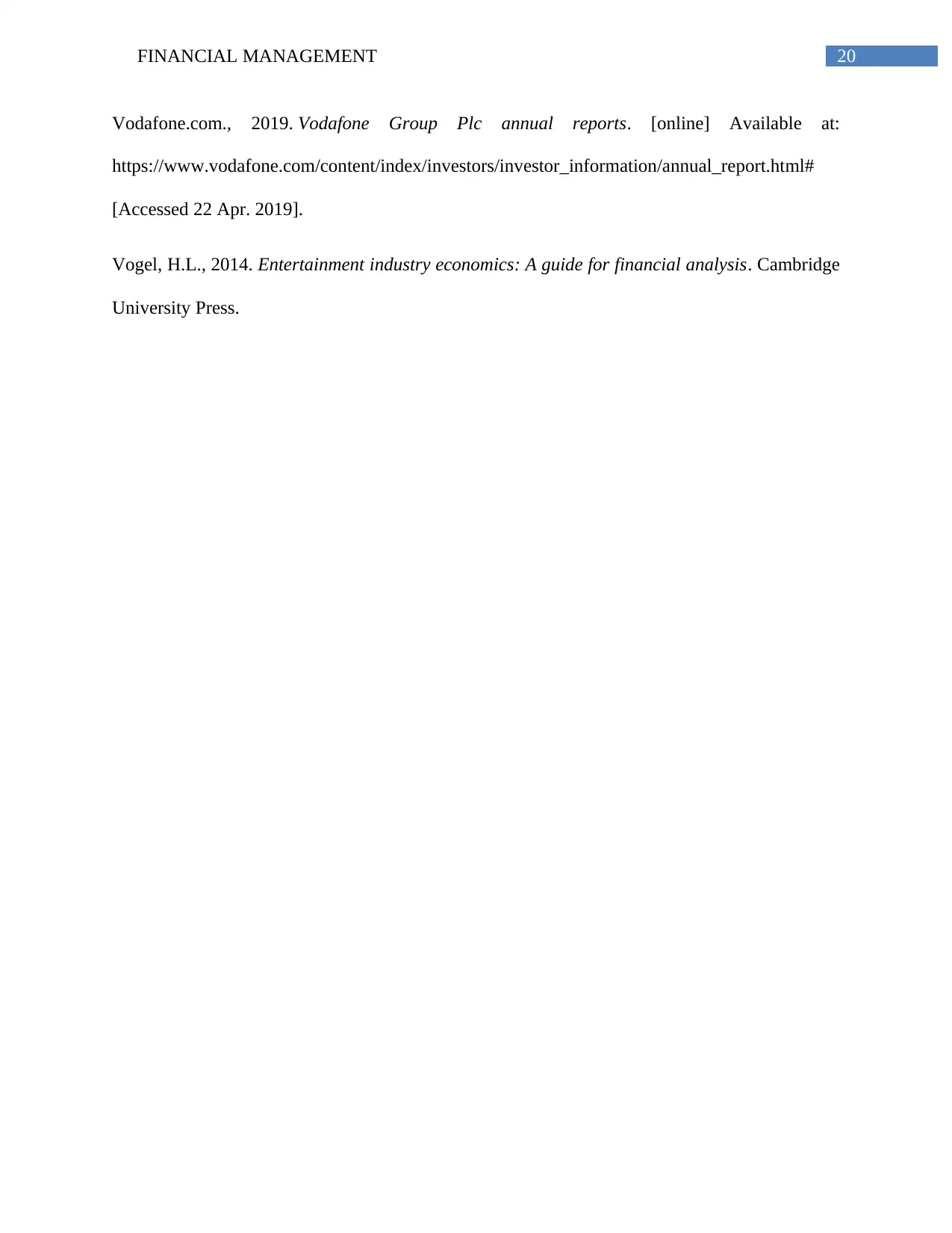
20FINANCIAL MANAGEMENT
Vodafone.com., 2019. Vodafone Group Plc annual reports. [online] Available at:
https://www.vodafone.com/content/index/investors/investor_information/annual_report.html#
[Accessed 22 Apr. 2019].
Vogel, H.L., 2014. Entertainment industry economics: A guide for financial analysis. Cambridge
University Press.
Vodafone.com., 2019. Vodafone Group Plc annual reports. [online] Available at:
https://www.vodafone.com/content/index/investors/investor_information/annual_report.html#
[Accessed 22 Apr. 2019].
Vogel, H.L., 2014. Entertainment industry economics: A guide for financial analysis. Cambridge
University Press.
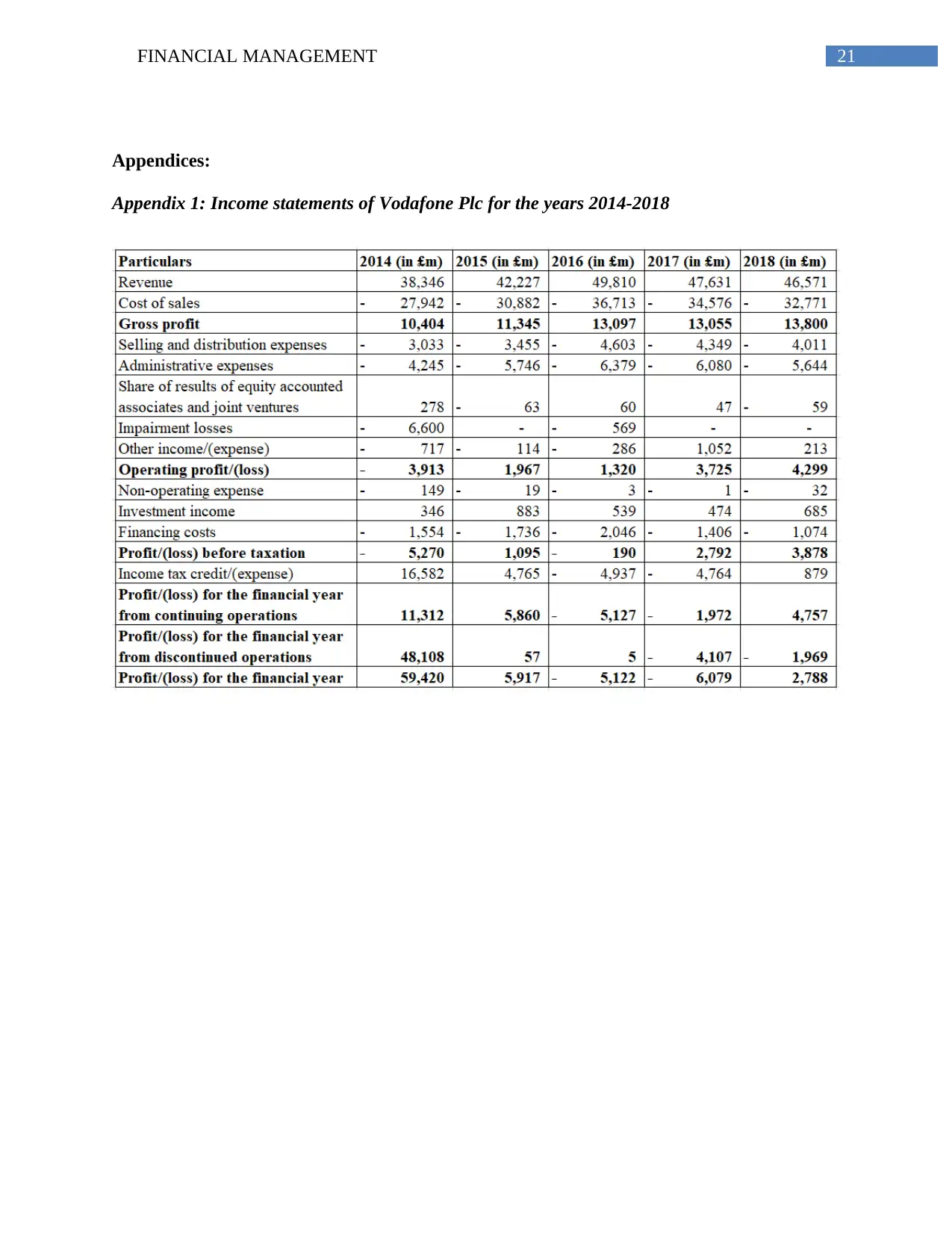
21FINANCIAL MANAGEMENT
Appendices:
Appendix 1: Income statements of Vodafone Plc for the years 2014-2018
Appendices:
Appendix 1: Income statements of Vodafone Plc for the years 2014-2018
Secure Best Marks with AI Grader
Need help grading? Try our AI Grader for instant feedback on your assignments.

22FINANCIAL MANAGEMENT
Appendix 2: Balance sheet statements of Vodafone Plc for the years 2014-2018
Appendix 2: Balance sheet statements of Vodafone Plc for the years 2014-2018
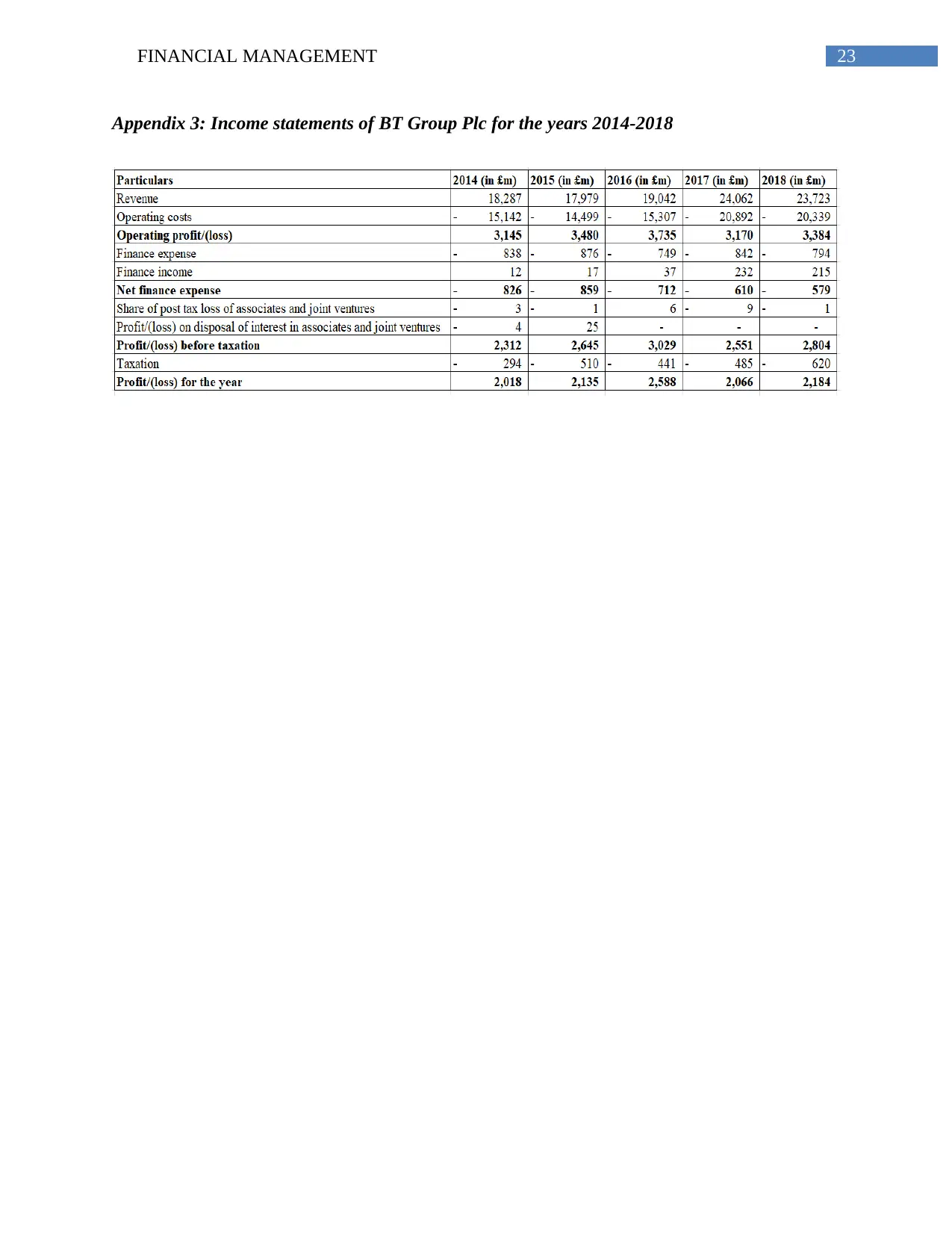
23FINANCIAL MANAGEMENT
Appendix 3: Income statements of BT Group Plc for the years 2014-2018
Appendix 3: Income statements of BT Group Plc for the years 2014-2018

24FINANCIAL MANAGEMENT
Appendix 4: Balance sheet statements of BT Group Plc for the years 2014-2018
Appendix 4: Balance sheet statements of BT Group Plc for the years 2014-2018
1 out of 25
Related Documents
Your All-in-One AI-Powered Toolkit for Academic Success.
+13062052269
info@desklib.com
Available 24*7 on WhatsApp / Email
![[object Object]](/_next/static/media/star-bottom.7253800d.svg)
Unlock your academic potential
© 2024 | Zucol Services PVT LTD | All rights reserved.





